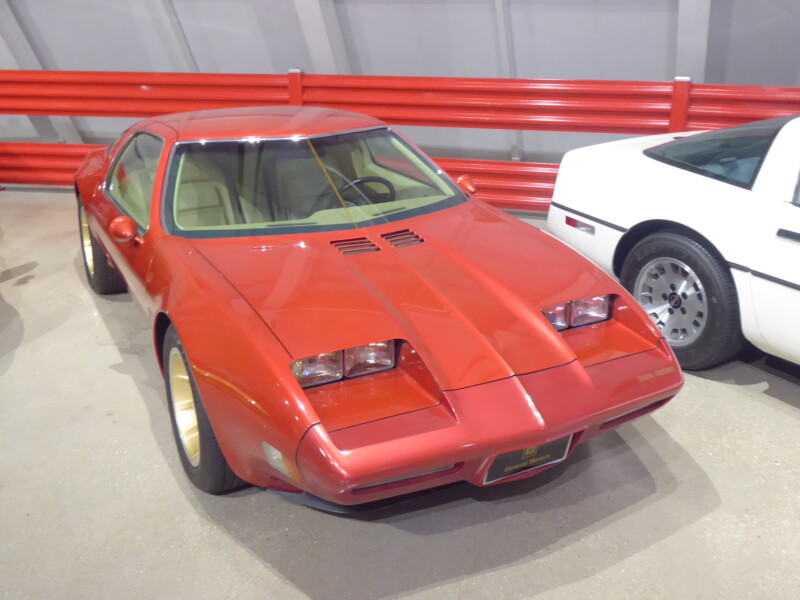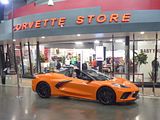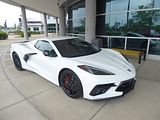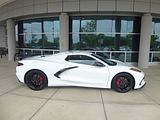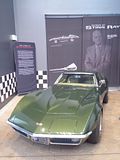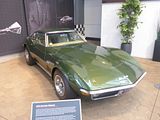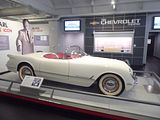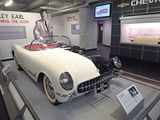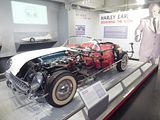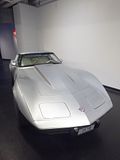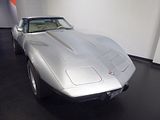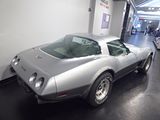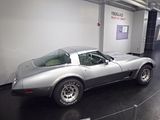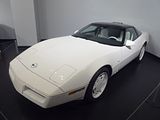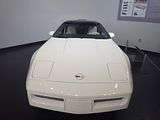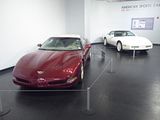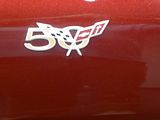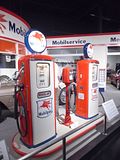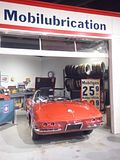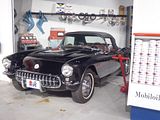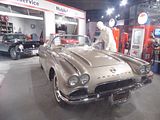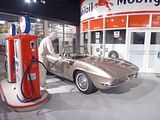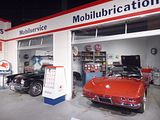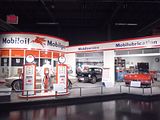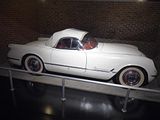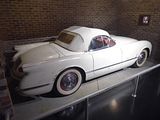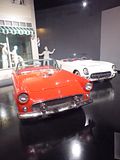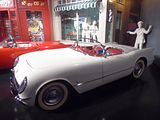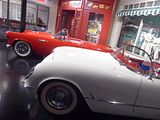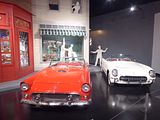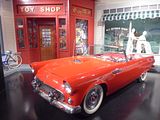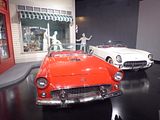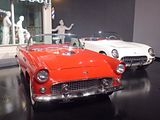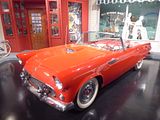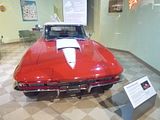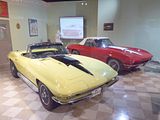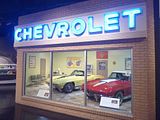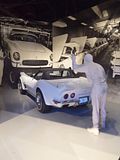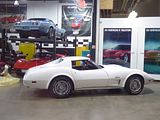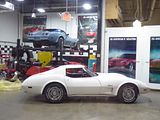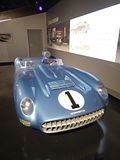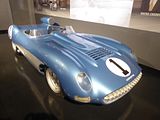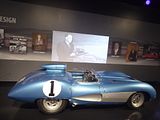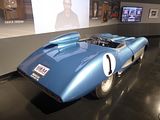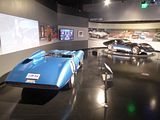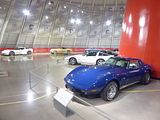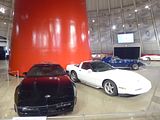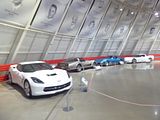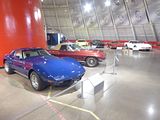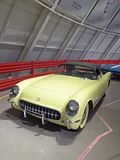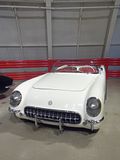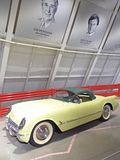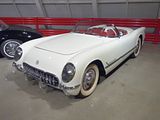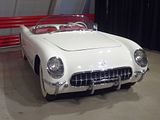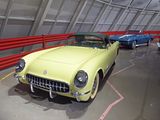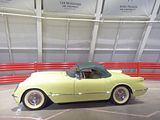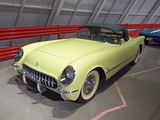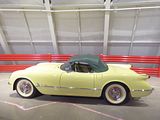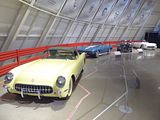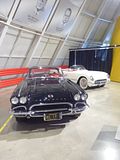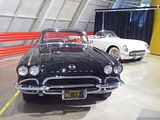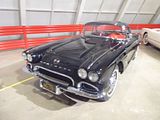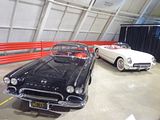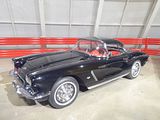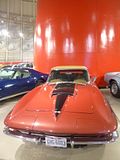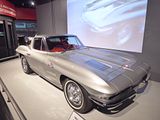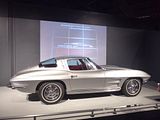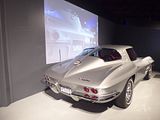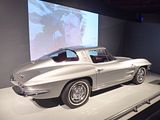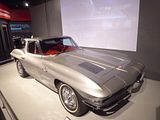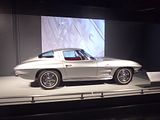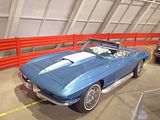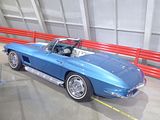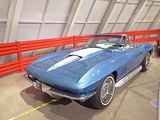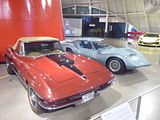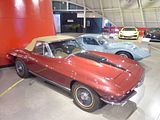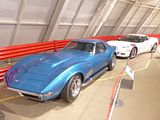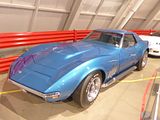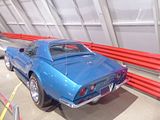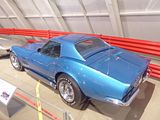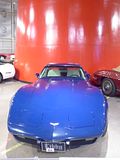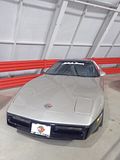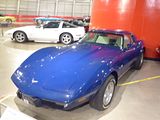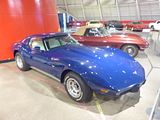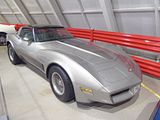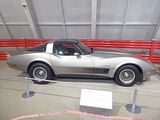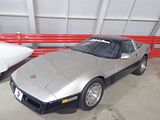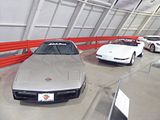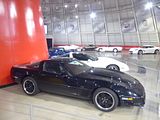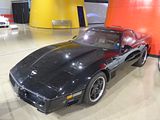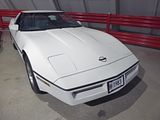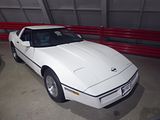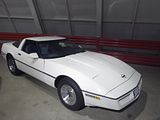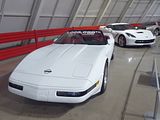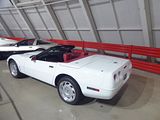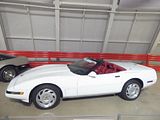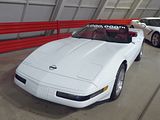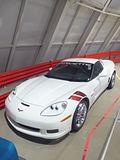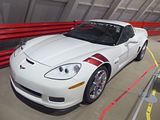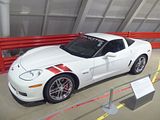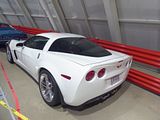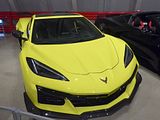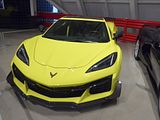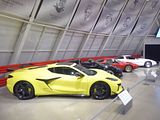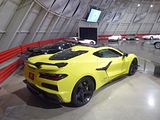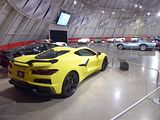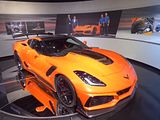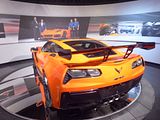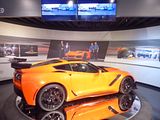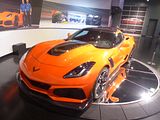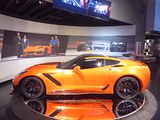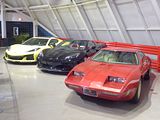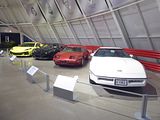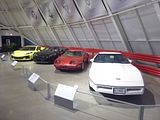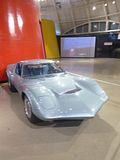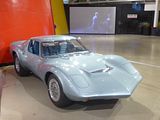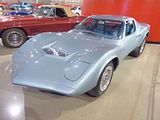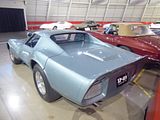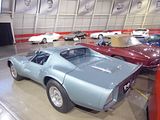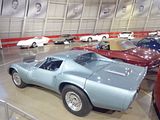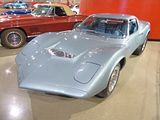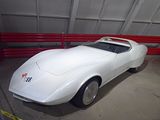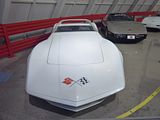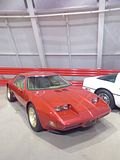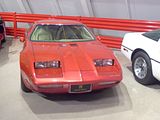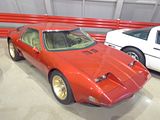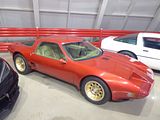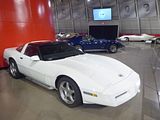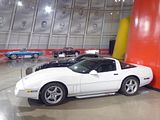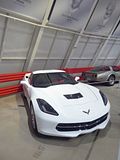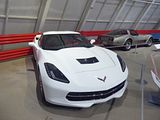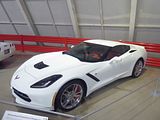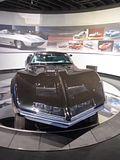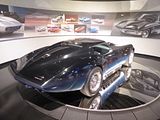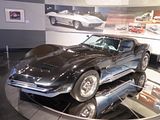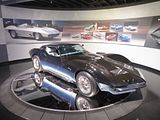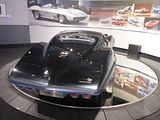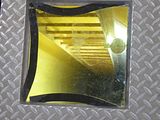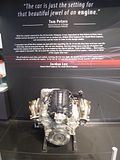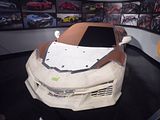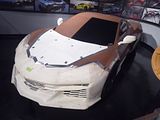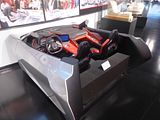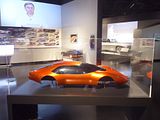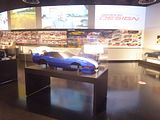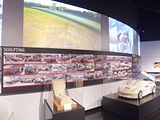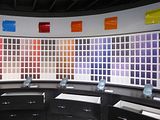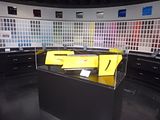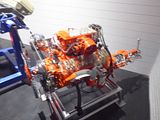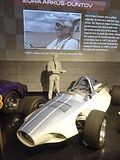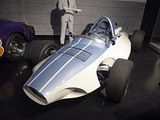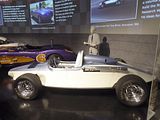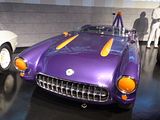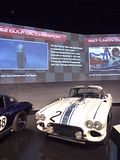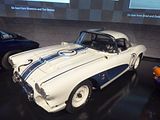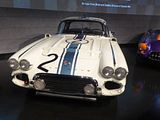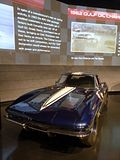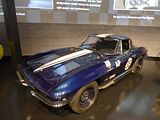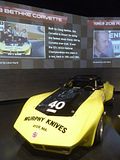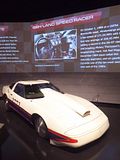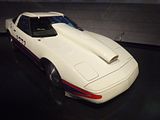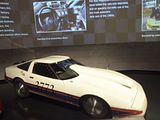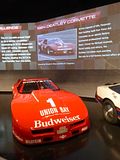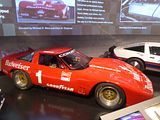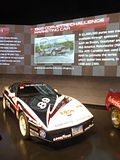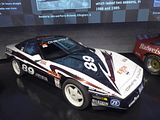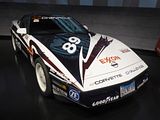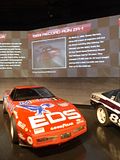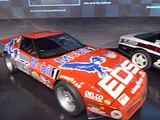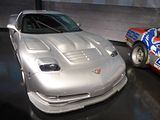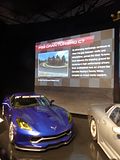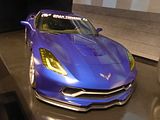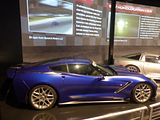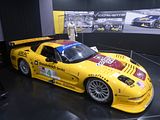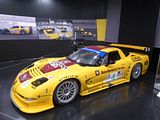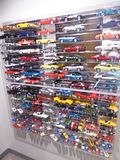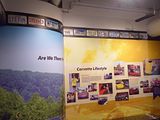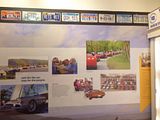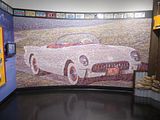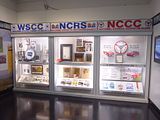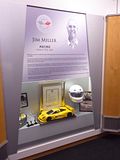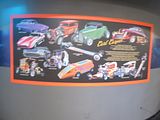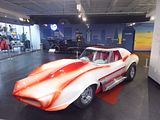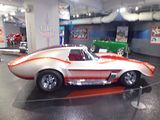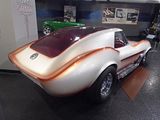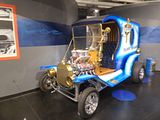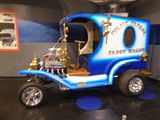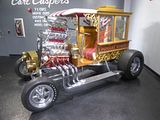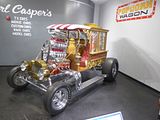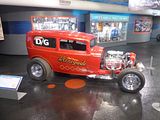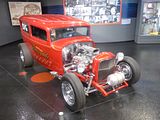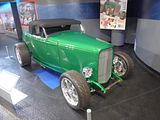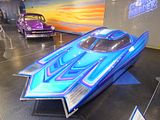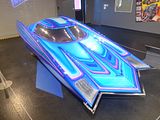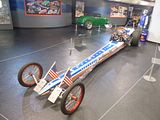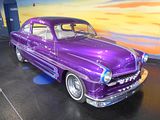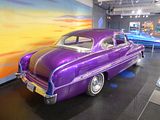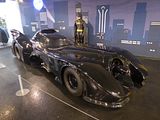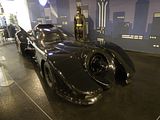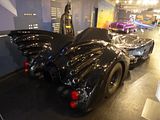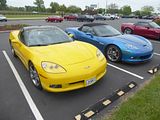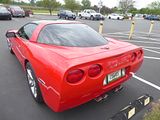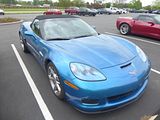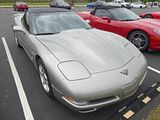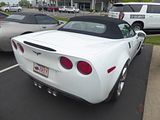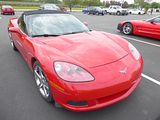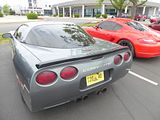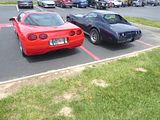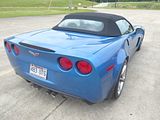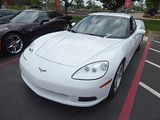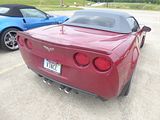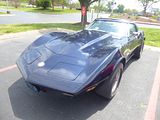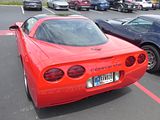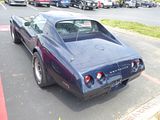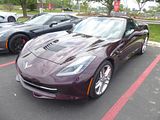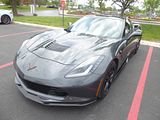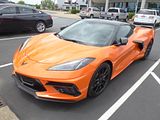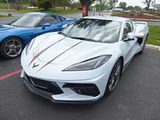Bowling Green, Kentucky, is not the sort of American city that many will have heard of, with a population of just 72,000 people, and located in the south central part of a State which is not high on the list of “must visit” for most people. But, if you are a Corvette fan, then I will wager that you have at least heard of it, even if you might struggle to locate it on a map, as since 1981, this has been the home of the Corvette, with a 70 year history, and a story that is not over yet. It was not long after the move to Bowling Green when thoughts to turned to building a museum to celebrate the amazing history of the car that is often referred to as America’s Sports Car. Constructed in 1994 and opened to the public in September of that year, the result was the National Corvette Museum, which is situated literally across the street from the assembly plant, and just a couple of miles off Interstate 65’s Exit 28 and it quickly achieved world renown for showcasing all things Corvette. The mission of the National Corvette Museum is to educate worldwide audiences on the evolution of the Corvette – America’s Sports Car – through collection, preservation, and celebration of its legacy. The museum offers captivating exhibits, immersive experiences, Corvette manufacturing plant tours, and unique offerings that engage visitors of all ages and backgrounds in the history of Corvette. It’s a place I have wanted to visit for a long time, but despite making numerous trips to America over the years, never found myself to be particularly close by. After years of this, at the start of 2023, I resolved to make plans for an entire trip which would take in the museum, and whatever else I could fit into what ended up as a 5 day visit flying in and out of Atlanta, GA, and driving up to Bowling Green. The city of Bowling Green is pretty small, it has to be said – though it does boast a railway museum, and it is only 40 miles, or so, from Mammoth Caves, which are well worth a visit, and further research suggested there is plenty to see in his generally rural part of America. I booked two nights in the area, arriving in the evening, giving me a full day to explore the museum, and the environs before moving on. It was a weekend, so I could not do the plant tour as well (the plant is literally across the road from the museum), but there was still plenty to interest me for a good few hours. Here is what I saw:
The museum is constructed with a series of rooms, including the museum itself, conference rooms, the extensive shop and a Corvette Diner, off a central concourse which is used, among other things, as a collection for proud new owners who are taking delivery of their brand new Corvette. There were a couple of collection ceremonies taking place during the time I was there.
At one end of the concourse is a link through to a workshop where the cars awaiting collection are prepped and stored.
Also here is a C3 generation 1970 Corvette Stingray, the first of a number of this, the longest lived version, at the museum.
As you enter the museum proper, there are a number of special edition Corvette models on display, to whet the appetite for what is to come.
Of course the display has to start with a very early Corvette and this is the car with chassis number #003. This car likely rolled off the assembly line in Flint on July 1, 1953. Not meant for sale, the model went directly to the GM Tech Center in Warren, Michigan, for testing. This third Corvette endured 14 hours of cold room shake testing, and a Belgian Block road test at the Milford Proving Grounds — eventually the body and chassis separated due to metal fatigue. A private party purchased the car in 2012, had it restored into this unique cutaway display, and donated it to the museum.
Joining it here are a number of the limited edition models that have been produced to celebrate various anniversaries of the Corvette.
1978 was the 25th anniversary of Corvette. Chevrolet brought out a brand new re-designed and upgraded 1978 Corvette with fastback styling, a new wrap-around rear window and a couple of special editions, a special “25th Anniversary Edition” that included a unique Charcoal Silver/Silver Metallic two-tone paint job and a 1978 Corvette Indy 500 Limited Edition Pace Car Replica. Every 1978 Corvette came with special 25th anniversary badging but the special “Anniversary Edition” included a unique two-tone paint job in Charcoal Silver and Silver Metallic and 15,283 1978 Corvettes were eventually sold with this paint. That special paint package cost an additional $399 over the base price of the car, and had special “Silver Anniversary” badges, aluminium wheels, and dual “sport” outside mirrors as mandatory options, which added another $380 to the total cost of the car.
1988 marked the 35th anniversary for Corvette, and so it was decided that Chevrolet should commemorate the milestone by introducing an anniversary-edition model. While this concept was not new to Corvette (Chevrolet had previously introduced a “Silver Anniversary” Corvette in 1978), this anniversary car was the first of its kind in a decade, given that Chevrolet opted not to manufacture a Corvette in 1983 (which would have marked Corvette’s 30th anniversary). The 35th Anniversary Edition Corvette was very much a car of its time. It came finished in a “Miami-Vice-esque” triple white finish. The car featured a bright white body that was offset by a black roof halo and windshield frame accompanied by a transparent acrylic roof panel. Most of the car’s exterior accents were also finished in bright white, including the door handles, mirrors, the bodyside moldings and the car’s 17-inch wheels. On its interior, the car received white leather seats, a white centre console cover, white interior door trim and a white steering wheel. Even the floormats, which were finished in graphite, included a thin white band around their edges. White the distinctive look of the car set it apart from other 1988 Corvettes, the car also received a number of other appointments as part of its Anniversary packaging. Each Anniversary Edition Corvette received commemorative badges which were installed just above the body side gills. Each car was also fitted with a commemorative console-mounted anniversary plaque just behind the shifter. The car also received a number of features including: dual six-way power sports seats (again, finished in white), automatic climate control, a GM Delco/Bose audio system and heated door mirrors. Like all 1988 Corvettes coupes that year, the 35th Anniversary Corvette could be ordered with an optional 3.07:1 performance rear axle. When so equipped, the car also included an improved muffler system that provided less restrictive airflow, resulting in a bump of 5 hp to 245 hp for so-optioned models. All other 1988 Corvettes still made 240 hp. When the car was first conceived, Chevrolet announced that they would manufacture a limited production of just 2,000 Special Anniversary Corvettes for the occasion. Further, it was announced that this anniversary model would only be offered as a coupe. The car could be ordered by consumers by selecting the Regular Production Option (RPO) Z01 – “The 35th Special Edition Package (coupe)” at an additional cost of $4,795.00 over the 1988 Corvette Coupe’s base price of $29,489.00.
Another decade – another milestone anniversary edition Corvette. However, the 2003 model year was especially significant as it marked the 50th year of the Corvette’s production at Chevrolet. To commemorate a half-century of manufacturing, every Corvette built in 2003 was adorned with special “50th Anniversary” badging – a unique “50” badge on each of the front fenders above the bodyside coves, and a special crossed flags badge on the nose and rear fascia that included “50 Anniversary” badging in the oval surrounding the crossed flags. A special “50th Anniversary Edition” package (RPO ISC) was also offered to consumers on the coupe and convertible models. When so equipped, these cars came finished in a special 50th Anniversary Red exterior paint with an exclusive Shale interior that included specially embroidered seats and 50th Anniversary logoed floor mats. Champaign-painted five-spoke wheels with special centre caps were also included as part of the package. Likewise, convertibles also received a Shale-coloured soft top. The 50th Anniversary package set consumers back $48,895 for a coupe and $55,370 for a convertible. For 50 years, the Chevrolet Corvette has been carefully crafted from a precise blend of power, performance, style and comfort. As it celebrates five colourful decades in the automotive business in 2003, Chevrolet’s flagship continues its reign as one of GM’s technology and style leaders. The 50th Anniversary Special Edition, available only during the 2003 model year on coupe and convertible models, is a tribute to a half-century of automotive leadership. It includes special Anniversary Red exterior paint, specific badging, Shale interior and champagne-painted anniversary wheels with special emblems. It also features embroidered badges on the seats and floormats, padded door armrests and grips and the convertible features a Shale top. The package includes Magnetic Selective Ride Control. New on the Corvette for 2003, Magnetic Selective Ride Control uses a revolutionary damper design that controls wheel and body motion with Magneto-Rheological fluid in the shocks . By controlling the current to an electromagnetic coil inside the piston of the damper, the MR fluid consistency can be changed, resulting in continuously variable real time damping. As a result, drivers feel a greater sense of security, a quieter, flatter ride and more precise, responsive handling, particularly during sudden, high-speed manoeuvres.
When Corvette reached the 40-year milestone through both feast and famine, Chevrolet saw cause to celebrate with a special-order 40th Anniversary Package. Priced at $1,455, the 40th Anniversary package was available in both standard and ZR1 models and included an eye-catching Ruby Red Metallic exterior finish, Ruby Red leather Sport seats, power driver seat, special wheel centre trim and 40th anniversary emblems inside and out. On convertible models so equipped, even the folding soft top was constructed of a matching Ruby Red material. To Corvette enthusiasts enjoying the car’s new-found performance, the 40th Anniversary Package was beautiful icing on a very tasty cake. Standard horsepower had shot from 245 to 300 HP the previous year, followed by an increase in torque from 330 to 340 lb-ft. The Corvette’s ride was refined by reducing front wheel and tire width, and for the first time in GM history, was offered with a passive keyless entry system. 2043 of these were built.
Progressing through to the next area of the museum, the tale of the Corvette, and its development, and then the dogged persistence of a handful of supporters for the car which kept it in production when the sales figures suggested that this was not necessarily the sensible course of action, begin to unfold.
Richard Sampson of Brunswick, Maine, bought a brand-new Corvette in 1954. After driving the car for some years, he acknowledged that his wife did not enjoy riding with him in the car, so he no longer wanted to drive it. Rather than sell the car, Sampson had it entombed during construction of one of his new grocery stores, with instructions in his will stating that the car could not be disturbed until 2000. He removed that stipulation shortly before his death in 1969, and in 1986 Sampson’s daughter had the car removed to her home to Daytona Beach, Florida, where she kept the car in her living room for 10 years. This car is now on display here at the Corvette museum, remaining exactly as it was when removed from the tomb.
There are two period style garages here as well as a recreation of a combined fuel station and servicing and oil change facility. The first of the garages shows us a 1955 Corvette with what would initially seem to be its main rival, the Ford Thunderbird.
The second garage shows us two examples of the 1967 C2 generation Corvette Stingray, one of which is the former property of the late Roy Orbison.
Further special displays show a 1970s garage and the assembly of a C3 Corvette when the chassis and body are married up.
Dating from 1957 is this Corvette SS (XP-64). The vast majority of history’s great ideas have stemmed from a need to rectify a previously observed issue. Ironically, much in the way of automotive design also follows this same thought process. As the Corvette has now transitioned into its new mid-engine configuration, it is only natural to inquire as to the origin of this design. While Zora Arkus-Duntov’s early insistence toward such design changes has been highly publicized, the inspiration behind his thought process has seldom received much attention. In order to understand the origin of Duntov’s fixation toward all that was mid-engine in form, one must look back to a time when the Corvette was still in its infancy. During this time period, Duntov would build a staggering number of experimental vehicles, most of which were intended to provide the Corvette line with performance credibility. It was a technical issue encountered while testing the prototype XP-64, also known as the Corvette SS, that would ultimately lead Dutov down the perpetual rabbit hole of continual mid-engine development. Almost immediately after coming on board with GM’s design team, Zora Arkus-Duntov set his sights on refining the Corvette’s image. Duntov believed that the only viable means of promoting the Corvette was by building its racing credibility. As such, he became engrossed in the idea of building a Corvette capable of conquering such famed races as Sebring and Le Mans. After several prior attempts at building a Corvette inspired racer for the ages, Duntov had his eye on a new, much more ambitious project. He intended to build a lightweight racer, which would be capable of reaching astounding speeds, while still handling with the utmost efficiency. Dubbed project XP-64, the creation of clay renderings commenced. Subsequently, a fiberglass prototype of this experimental vehicle would be built and tested to a relatively high degree of success. In a bid to shed any excessive wait possible, a second car would be built, this time with a magnesium body. The Corvette SS was then fitted with a modified 283 cubic-inch V8. In its refined form, the Corvette SS was capable of producing 307 bhp at 6,400 rpm. With the new magnesium-bodied Corvette SS tested, plans were made to mount a dominant showing at 12 Hours of Sebring. Final adjustments were made to the race-derived prototype, and it was shipped to the track ahead of the competition. Driven by Piero Taruffi and John Fitch, the Corvette SS, struck out on race day, with hopes at an all-time high. However, an assault on Sebring simply was not to be. Almost immediately, several technical issues arose. After only 23 laps, the Corvette SS was ultimately pulled from the competition, due to electrical, brake, and rear-end issues. While all such issues could easily be remedied in the days and weeks to come, a much more serious problem had also become apparent. During the race, Taruffi and Fitch stated that cockpit temperatures rose to an almost unbearable level, as heat from the Corvette SS’s engine radiated rearward. As a result, Arkus-Duntov began to delve into the matter of preventing such difficulties in the future. In true Duntov fashion, it was not long before the famed automotive engineer settled upon a solution. Inspired by many European racers of the day, Duntov emerged resolute in his insistence that future prototypes, as well as the Corvette itself, should be transitioned to a mid-engine layout. This would eliminate rearward radiation of engine heat into a vehicle’s cockpit, thereby enhancing driver comfort, and opening the door to numerous means of technical powertrain advancement. Almost immediately after the Corvette SS’s failed trial at Sebring, the prototype would be decommissioned from service. The newly implemented AMA ban on factory-backed racing would end any such efforts for decades to come, leaving the Corvette SS with little potential use. Meanwhile, Duntov would spend the better part of his remaining career championing the Corvette’s transition to a mid-engine layout. Unfortunately, these pleas would fall on deaf ears. Though a number of Duntov’s subsequent mid-engine concepts would prove viable, none would be tapped for production. Today, the Corvette has finally taken on a mid-engine configuration, some 60-plus years after Duntov’s initial insistence. While the famed engineer is no longer around to witness the Corvette in its current form, one would assume that he would be quite pleased.
The central part of the museum, known as the Skydome, contains the majority of the cars. Around the outer perimeter is a timeline which features an example of each of the 8 generations of Corvette.
The first generation of Corvette was introduced late in the 1953 model year. Originally designed as a show car for the 1953 Motorama display at the New York Auto Show, it generated enough interest to induce GM to make a production version to sell to the public. First production was on June 30, 1953. This generation was often referred to as the “solid-axle” models (the independent rear suspension was not introduced until the second generation).Three hundred hand-built polo white Corvette convertibles were produced for the 1953 model year. The 1954 model year vehicles could be ordered in Pennant Blue, Sportsman Red, Black, or Polo White. 3,640 were built, and sold slowly. The 1955 model offered a 265 cu in (4.34 litre) V8 engine as an option. With a large inventory of unsold 1954 models, GM limited production to 700 for 1955. With the new V8, the 0-60 mph time improved by 1.5 seconds. A new body was introduced for the 1956 model featuring a new “face” and side coves; the taillamp fins were also gone. An optional fuel injection system was made available in the middle of the 1957 model year. It was one of the first mass-produced engines in history to reach 1 bhp per cubic inch (16.4 cc) and Chevrolet’s advertising agency used a “one hp per cubic inch” slogan for advertising the 283 bhp 283 cu in (4.64 litre) Small-Block engine. Other options included power windows (1956), hydraulically operated power convertible top (1956), heavy duty brakes and suspension (1957), and four speed manual transmission (late 1957). Delco Radio transistorised signal-seeking “hybrid” car radio, which used both vacuum tubes and transistors in its radio’s circuitry (1956 option).
The 1958 Corvette received a body and interior freshening which included a longer front end with quad headlamps, bumper exiting exhaust tips, a new steering wheel, and a dashboard with all gauges mounted directly in front of the driver. Exclusive to the 1958 model were bonnet louvres and twin trunk spears. The 1959–60 model years had few changes except a decreased amount of body chrome and more powerful engine offerings. In 1961, the rear of the car was completely redesigned with the addition of a “duck tail” with four round lights. The light treatment would continue for all following model year Corvettes until 2014. In 1962, the Chevrolet 283 cu in (4.64 litre) Small-Block was enlarged to 327 cu in (5.36 litre). In standard form it produced 250 bhp. For an extra 12% over list price, the fuel-injected version produced 360 bhp, making it the fastest of the C1 generation. 1962 was also the last year for the wrap around windshield, solid rear axle, and convertible-only body style. The boot lid and exposed headlamps did not reappear for many decades. An all-new C2 generation model was launched for 1963.
Showing the evolution of the Corvette was this second generation C2 model. First seen in 1963, this model introduced us to the name Sting Ray. It continued with fibreglass body panels, and overall, was smaller than the first generation. The car was designed by Larry Shinoda with major inspiration from a previous concept design called the “Q Corvette,” which was created by Peter Brock and Chuck Pohlmann under the styling direction of Bill Mitchell. Earlier, Mitchell had sponsored a car known as the “Mitchell Sting Ray” in 1959 because Chevrolet no longer participated in factory racing. This vehicle had the largest impact on the styling of this generation, although it had no top and did not give away what the final version of the C2 would look like. The third inspiration was a Mako Shark Mitchell had caught while deep-sea fishing. Production started for the 1963 model year and ended in 1967. The 1963 model was the first year for a Corvette coupé and it featured a distinctive tapering rear deck (a feature that later reappeared on the 1971 “Boattail” Buick Riviera) with, for 1963 only, a split rear window. The Sting Ray featured hidden headlamps, non-functional bonnet vents, and an independent rear suspension. Corvette chief engineer Zora Arkus-Duntov never liked the split rear window because it blocked rear vision, but Mitchell thought it to be a key part of the entire design. Maximum power for 1963 was 360 bhp, raised to 375 bhp in 1964. Options included electronic ignition, the breakerless magnetic pulse-triggered Delcotronic first offered on some 1963 Pontiac models. On 1964 models the decorative bonnet vents were eliminated and Duntov, the Corvette’s chief engineer, got his way with the split rear window changed to a full width window. Four-wheel disc brakes were introduced in 1965, as was a “big block” engine option: the 396 cu in (6.49 litre) V8. Side exhaust pipes were also optionally available in 1965, and continued to be offered through 1967. The introduction of the 425 bhp 396 cu in big block in 1965 spelled the beginning of the end for the Rochester fuel injection system. The 396 cu in option cost $292.70 while the fuel injected 327 cu in (5.36 litre) engine cost $538.00. Few people could justify spending $245.00 more for 50 bhp less, even though FI could deliver over 20 mpg on the highway and would keep delivering fuel despite high G-loading in corners taken at racing speeds. Another rare ’63 and ’64 option was the Z06 competition package, which offered stiffer suspension, bigger, multi-segment lined brakes with finned drums and more, only a couple hundred coupes and ONE convertible were factory-equipped this way in 1963. With only 771 fuel-injected cars built in 1965, Chevrolet discontinued the option at the end of the ’65 production, having introduced a less-expensive big block 396 engine rated at 425 hp in the middle of the production year and selling over 2,000 in just a few months. For 1966, Chevrolet introduced an even larger 427 cu in 7 litre Big Block version. Other options available on the C2 included the Wonderbar auto-tuning AM radio, AM-FM radio (mid-1963), air conditioning (late-1963), a telescopic steering wheel (1965), and headrests (1966). The Sting Ray’s independent rear suspension was successfully adapted for the new-for-1965 Chevrolet Corvair, which solved the quirky handling problems of that unique rear-engine compact. 1967 was the final year for the C2 generation. The 1967 model featured restyled bumper vents, less ornamentation, and back-up lamps which were on the inboard in 1966 were now rectangular and centrally located. The first use of all four taillights in red started in 1961 and was continued thru the C-2 line-up except for the 1966. The 1967 and subsequent models continuing on all Corvettes since. 1967 had the first L88 engine option which was rated at 430 bhp, but unofficial estimates place the actual output at 560 bhp or more. Only twenty such engines were installed at the factory. From 1967 (to 1969), the Holley triple two-barrel carburettor, or Tri-Power, was available on the 427 L89 (a $368 option, on top of the cost for the high-performance 427). Despite these changes, sales slipped over 15%, to 22,940 – 8,504 coupes and 14,436 convertibles.
The third generation Corvette, patterned after the Mako Shark II concept car, was introduced for the 1968 model year and was in production until 1982. C3 coupes featured the first use of T-top removable roof panels. The C3 introduced monikers that were later revived, such as LT-1, ZR-1, Z07 and Collector Edition. In 1978, the Corvette’s 25th anniversary was celebrated with a two-tone Silver Anniversary Edition and an Indy Pace Car replica edition of the C3. This was also the first time that a Corvette was used as a Pace Car for the Indianapolis 500. Engines and chassis components were mostly carried over from the C2, but the body and interior were new. The 350 cu in (5.7 litre) engine replaced the old 327 cu in (5.36 litre) as the base engine in 1969, but power remained at 300 bhp. 1969 was the only year for a C3 to optionally offer either a factory installed side exhaust or normal rear exit with chrome tips. The all-aluminium ZL1 engine was also new for 1969; the special big-block engine was listed at 430-hp , but was reported to produce 560 hp and propelled a ZL1 through the 1/4 mile in 10.89 seconds. There was an extended production run for the 1969 model year due a lengthy labour strike, which meant sales were down on the 1970 models, to 17,316. 1970 small-block power peaked with the optional high compression, high-revving LT-1 that produced 370 bhp. The 427 big-block was enlarged to 454 cu in (7.44 litre) with a 390 bhp rating. The ZR-1 special package was an option available on the 1970 through 1972 model years, and included the LT-1 engine combined with special racing equipment. Only 53 ZR-1’s were built. In 1971, to accommodate regular low-lead fuel with lower anti-knock properties, the engine compression ratios were lowered which resulted in reduced power ratings. The power rating for the 350 cu in (5.7 litre) L48 base engine decreased from 300 to 270 hp and the optional special high performance LT1 engine decreased from 370 to 330 hp. The big-block LS6 454 was reduced from 450 to 425 bhp, though it was not used in Corvettes for 1970; it was used in the Chevelle SS. For the 1972 model year, GM moved to the SAE Net measurement which resulted in further reduced, but more realistic, power ratings than the previous SAE Gross standard. Although the 1972 model’s 350 cu in horsepower was actually the same as that for the 1971 model year, the lower net horsepower numbers were used instead of gross horsepower. The L48 base engine was now rated at 200 bhp and the optional LT1 engine was now rated at 270 bhp. 1974 models had the last true dual exhaust system that was dropped on the 1975 models with the introduction of catalytic converters requiring the use of no-lead fuel. Engine power decreased with the base ZQ3 engine producing 165 bhp), the optional L82’s output 250 bhp, while the 454 big-block engine was discontinued. Gradual power increases after 1975 peaked with the 1980 model’s optional L82 producing 230 bhp. Styling changed subtly throughout the generation until 1978 for the car’s 25th anniversary. The Sting Ray nameplate was not used on the 1968 model, but Chevrolet still referred to the Corvette as a Sting Ray; however, the 1969 (through 1976) models used the “Stingray” name as one word, without the space. In 1970, the body design was updated including fender flares, and interiors were refined, which included redesigned seats, and indication lights near the gear shift that were an early use of fibre optics . Due to government regulation, the 1973 Corvette’s chrome front bumper was changed to a 5-mile-per-hour (8 km/h)system with a urethane bumper cover. 1973 Corvettes are unique in that sense, as they are the only year where the front bumper was polyurethane and the rear retained the chrome two-piece bumper set. 1973 was also the last year chrome bumpers were used. The optional wire-spoked wheel covers (left) were offered for the last time in 1973. Only 45 Z07 were built in 1973.
From 1974 onwards both the front and rear bumpers were polyurethane. In 1974, a 5-mph rear bumper system with a two-piece, tapering urethane bumper cover replaced the Kamm-tail and chrome bumper blades, and matched the new front design from the previous year. 1975 was the last year for the convertible, (which did not return for 11 years). For the 1976 models the fibreglass floor was replaced with steel panels to provide protection from the catalytic converter’s high operating temperature. 1977 was last year the tunnelled roof treatment with vertical back window was used, in addition leather seats were available at no additional cost for the first time. The 1978 25th Anniversary model introduced the fastback glass rear window and featured a new interior and dashboard. Corvette’s 25th anniversary was celebrated with the Indy 500 Pace Car limited edition and a Silver Anniversary model featuring silver over gray lower body paint. All 1979 models featured the previous year’s pace car seats and offered the front and rear spoilers as optional equipment. 53,807 were produced for the model year, making 1979 the peak production year for all versions of the Corvette. Sales have trended downward since then. In 1980, the Corvette received an integrated aerodynamic redesign that resulted in a significant reduction in drag. After several years of weight increases, 1980 Corvettes were lighter as engineers trimmed both body and chassis weight. In mid-1981, production shifted from St. Louis, Missouri to Bowling Green, Kentucky, and several two-tone paint options were offered. The 1981 models were the last available with a manual transmission until well into the 1984 production run. In 1982, a fuel-injected engine returned, and a final C3 tribute Collectors Edition featured an exclusive, opening rear window hatch.
Next up chronologically was this C4 Corvette, the fourth generation to near the name. It was was the first complete redesign of the Corvette since 1963. Production was to begin for the 1983 model year but quality issues and part delays resulted in only 43 prototypes for the 1983 model year being produced that were never sold. All of the 1983 prototypes were destroyed or serialised to 1984 except one with a white exterior, medium blue interior, L83 350 ci, 205 bhp V8, and 4-speed automatic transmission. After extensive testing and modifications were completed, it was initially retired as a display sitting in an external wall over the Bowling Green Assembly Plant’s employee entrance. Later this only surviving 1983 prototype was removed, restored and is now on public display at the National Corvette Museum in Bowling Green, Kentucky. It is still owned by GM. On February 12, 2014, it was nearly lost to a sinkhole which opened up under the museum. Regular fourth generation production began on January 3, 1983; the 1984 model year and delivery to customers began in March 1983. The 1984 model carried over the 350 cu in (5.7 litre) L83 slightly more powerful (5 bhp) “Crossfire” V8 engine from the final 1982 third generation model. New chassis features were aluminium brake calipers and an all-aluminium suspension for weight savings and rigidity. The new one piece targa top had no centre reinforcement. A new electronic dashboard with digital liquid crystal displays for the speedometer and tachometer was standard. Beginning in 1985, the 230 bhp L98 engine with tuned port fuel injection became the standard engine. September 1984 through 1988 Corvettes offered a Doug Nash designed “4+3” transmission – a 4-speed manual coupled to an automatic overdrive on the top three gears. It was designed to help the Corvette meet U.S. fuel economy standards. Since 1981, when it was last offered, a manual transmission returned to the Corvette starting with production in late-1984. The transmission proved to be problematic and was replaced by a modern ZF 6-speed manual transmission in 1989. In 1986, the second Corvette Indy Pace Car was released. It was the first convertible Corvette since 1975. A Centre High Mounted Signal Light – a third centre brake light – was added in 1986 to comply with safety regulations. While the colour of the pace car used in the race was yellow, all 1986 convertibles also had an Indy 500 emblem mounted on the console, making any colour a “pace car edition”. In 1987, the B2K twin-turbo option became available from the factory. The Callaway Corvette was a Regular Production Option (RPO B2K). The B2K option coexisted from 1990 to 1991 with the ZR-1 option, which then replaced it. Early B2Ks produced 345 bhp and 450 lb·ft later versions boasted 450 bhp and 613 lb·ft .1988 saw the 35th Anniversary Edition of the Corvette. Each of these featured a special badge with an identification number mounted next to the gear selector, and were finished with a white exterior, wheels, and interior. In 1991, all Corvettes received updates to the body, interior, and wheels. The convex rear fascia that set the 1990 ZR-1 apart from the base model was now included on L98 Corvettes, making the styling of the expensive ZR-1 even closer to that of the base cars. The most obvious difference remaining between the base and ZR-1 models besides the wider rear wheels was the location of the CHMSL, which was integrated into the new rear fascia used on the base model, but remained at the top of the rear-hatch on the ZR-1’s. For the 1992 model year, the 300 bhp LT1 engine was introduced, an increase of 50 bhp over 1991’s L98 engine. This engine featured reverse-flow cooling (the heads were cooled before the block), which allowed for a higher compression ratio of 10.5:1. A new distributor was also debuted. Called “Optispark”, the distributor was driven directly off the front of the camshaft and mounted in front of the timing cover, just above the crankshaft and harmonic balancer. Also new for 1992 was Acceleration Slip Regulation (ASR), a form of traction control which utilised the Corvette’s brakes, spark retard, and throttle close-down to prevent excessive rear wheel spin and possible loss of control. The traction control device could be switched off if desired. A special 40th Anniversary Edition was released in 1993, which featured a commemorative Ruby Red colour, 40th anniversary badges, and embroidered seat backs. The 1993 Corvette also marked the introduction of the Passive Keyless Entry System, making it the first GM car to feature it. Production of the ZR-1 ended in 1995, after 6,939 cars had been built.[46] 1996 was the final year of C4 production, and featured special models and options, including the Grand Sport and Collector Edition, OBD II (On-Board Diagnostics), run flat tyres, and the LT4 engine. The 330 bhp LT4 V8 was available only with a manual transmission, while all 300 bhp LT1 Corvettes used automatic transmissions. Chevrolet released the Grand Sport (GS) version in 1996 to mark the end of production of the C4 Corvette. The Grand Sport moniker was a nod to the original Grand Sport model produced in 1963. A total of 1,000 GS Corvettes were produced, 810 as coupes and 190 as convertibles. The 1996 GS came with the high-performance LT4 V8 engine, producing 330 bhp and 340 lb·ft . The Grand Sport came only in Admiral Blue with a white stripe down the middle, and black wheels and two red stripes on the front left wheel arch.
The C5 Corvette was redesigned from the ground up after sales from the previous generation began to decline. Production of the C5 Corvette actually began in 1996 but quality/manufacturing issues saw its release to the public in mass delayed until 1997, and continuing through the 2004 model year. The C5 was a completely new design that featured many new concepts and manufacturing breakthroughs that would be carried forward to the C6 & C7. It had a top speed of 176 mph (283 km/h) and was judged by the automotive press as a breakthrough with vastly improved dynamics in nearly every area over the previous C4 design. Innovations included a 0.29 drag coefficient, near 50/50 weight distribution, active handling (the first stability control for a Corvette). It also weighed less than the C4. It was the first time the platform was badge engineered as the Cadillac XLR with limited sales. An all new LS1 aluminium engine (Gen III small block) featured individual ignition coils for each cylinder, and aluminium block and pistons. It was initially rated at 345 bhp and 350 lb/ft (470 Nm), but was increased to 350 bhp in the 2001 edition. The new engine, combined with the new body, was able to achieve up to 28 mpg on the highway. For its first year, the C5 was available only as a coupe, although the new platform was designed from the ground up to be a convertible, which returned in 1998, followed by the fixed-roof coupe (FRC) in 1999. One concept for the FRC was for it to be a stripped-down model with a possible V6 engine (nicknamed in-house as the “Billy Bob”). By 2000, FRC plans laid the groundwork for the return in 2001 of the Z06, an RPO option not seen since Zora’s 1963 race-ready Corvette. The Z06 model replaced the FRC model as the highest performance C5 Corvette. Instead of a heavier double-overhead cam engine like the ZR-1 of the C4 generation, the Z06 used an LS6, a 385 bhp derivative of the standard LS1 engine. Using the much more rigid fixed roof design allowed the Z06 unprecedented handling thanks to upgraded brakes and less body flex. Those characteristics, along with the use of materials such as a titanium exhaust system and a carbon fiber hood in the 2004 model year, led to further weight savings and performance gains for the C5 Z06. The LS6 was later upgraded to 405 bhp for 2002–2004. Although the Z06’s rated power output equal to that of the C4 ZR-1, the improved rigidity, suspension, brakes, and reduced weight of the C5 produced a car quicker than C4 ZR-1. A sixth generation model arrived for the 2005 model year. Seen here is the millionth Corvette built.
The C6 Corvette retained the front engine and rear transmission design of the C5, but was otherwise all-new, including new bodywork with exposed headlamps (for the first time since 1962), a larger passenger compartment, a new 6.0 litre engine and a reworked suspension geometry. It had a longer wheelbase than the C5, but its overall vehicle length and width were less than the C5, allegedly to widen appeal to the European market.The 6.0 litre LS2 V8 produced 400 bhp at 6000 rpm and 400 lb·ft at 4400 rpm, giving the vehicle a 0–60 time of under 4.2 seconds.Its top speed was 190 mph. The C6 generation did not match the previous generation’s relatively good fuel economy, despite its relatively low 0.28 drag coefficient and low curb weight, achieving 16/26 mpg (city/highway) equipped with automatic or manual transmissions; like all manual transmission Corvettes since 1989, it is fitted with Computer Aided Gear Selection (CAGS) to improve fuel economy by requiring drivers to shift from 1st gear directly to 4th in low-speed/low-throttle conditions. This feature helps the C6 avoid the Gas Guzzler Tax by achieving better fuel economy. The new Z06 arrived as a 2006 model in the third quarter of 2005. It has a 7.0 litre version of the small block engine codenamed LS7. At 427.6 cubic inches, the Z06 was the largest small block ever offered from General Motors. Because of the Corvette’s former use of 427 cubic-inch big blocks in the late-1960s and early 1970s, the LS7’s size was rounded down to 427 cubic inches. Official output was 505 bhp and has a 0-60 mph time of 3.7 seconds. Top speed is 198 mph. For 2008, the Corvette received a mild freshening: a new LS3 engine with displacement increased to 6.2 litres resulting in 430 bhp and 424 lb·ft. The 6-speed manual transmission also has improved shift linkage and a 0–60 time of 4.0 seconds, while the automatic is set up for quicker shifts giving the C6 automatic a 0–60 time of 4.0 seconds, faster than any other production automatic Corvette. The interior was slightly updated and a new 4LT leather-wrap interior package was added. The wheels were also updated to a new five-spoke design. ZR1 was formally announced in a December 2007 press statement by General Motors, where it was revealed that their target of 100 bhp per litre had been reached by a new “LS9″ engine with an Eaton-supercharged 6.2-litre engine producing 638 bhp and 604 lb·ft. The LS9 engine was the most powerful to be put into a GM production sports car. Its top speed was 205 mph. The historical name Grand Sport returned to the Corvette lineup in 2010 as an entirely new model series that replaced the Z51 option. The new model was basically an LS3 equipped Z06 with a steel frame instead of aluminium. It retained many of the features of the Z06 including a wide body with 18×9.5 and 19×12 inch wheels, dry sump oiling (manual transmission coupes only), 6-piston 14” front brakes and 4-piston rear, improved suspension, and front carbon fibre fenders. Manual power train equipped G/S coupe models receive a tweaked LS3 with a forged crank, are built in Z06 fashion by hand, and utilise a dry-sump oil system. The first three gears were also made shorter for better throttle response and faster acceleration. A new launch control system was introduced for all models that allows for sub 4 second 0-60. Beginning with the 2011 model year, buyers of the Corvette Z06 and ZR1 were offered the opportunity to assist in the build of their engine. Titled the “Corvette Engine Build Experience,” buyers paid extra to be flown to the Wixom, Michigan Performance Build Center.Participants helped the assembly line workers build the V8 engine, then took delivery of the car at the National Corvette Museum in Bowling Green, KY, near the Corvette final assembly point. The last C6 Corvette was manufactured in February 2013.
The next-generation (C7) Corvette had been in development since 2007. Originally set to be introduced for the 2011 model year, its introduction was delayed for 3 years. It was finally released for the 2014 model year. Mid-engine and rear-engine layouts had been considered, but the front-engine, rear-wheel drive platform was chosen to keep production costs lower. To GM’s product planners and marketers, the fact that the Corvette had become known as an “old man’s toy” became a prime factor in developing the next generation. Studies showed that about 46 percent of Corvette buyers in 2012, through October, were 55 or older, compared with 22 percent of Audi R8 and 30 percent of Porsche 911 customers. The head of Chevy marketing, Chris Perry, acknowledges that too many people saw it as the car of “the successful plumber.” John Fitzpatrick, Corvette’s marketing manager said “It’s the old saying, ‘Nobody wants to be seen driving an old man’s car, but everybody wants to be seen driving a young man’s car. ” To counter that perception GM planned to make the new generation C7 more aspirational to younger people. Towards that end, a camouflaged version of the car was made available in the popular video game Gran Turismo 5 in November 2012. As part of the marketing effort associated with the introduction of the new generation, the 2013 Indianapolis 500 utilised a Corvette for the 12th time as its pace car. Pace car editions are planned. Sales success of the new Corvette is important to GM. The Motley Fool reports that the Corvette could be earning GM $10,000 or more in gross profit for every Corvette it sells.The 2014 Chevrolet Corvette uses an LT1 6.2 litre V8 making 455 bhp. The LT1 engine is in the Gen 5 family of small block engines, which will be used in GM vehicles as the new small V8 option. It features three technologies new to the GM V8, though widely available on other engines in the marketplace: direct injection, variable valve timing, and an active fuel management system. Fuel injectors are located under the intake manifold. The Corvette remains rear-wheel drive with the transaxle located in the rear. Transmission choices include a 7-speed manual or a 8-speed automatic with paddle shifters. The new interior includes wide-bottom seats as standard, with sportier versions with high side bolsters optional. The Corvette’s flag logo has been revised for the new car and a small casting of a stingray has been added to the car’s ornamentation. Features of the new generation’s structure include a carbon fibre bonnet and removable roof panel. The fenders, doors and rear quarter panels remain composite. At the rear of the car, the trademark round taillights have changed to a more squarish form. The underbody panels are made of “carbon-nano” composite and it makes use of a new aluminium frame which locates the four wheels an inch farther apart, front to rear and side to side. Luggage space decreased by 33% from the previous generation’s. The overall weight of the car was not announced by General Motors for many months after its first showing in January 2013. Despite the increased use of aluminium and other light weight materials, numerous publications reported that the weight would remain essentially unchanged from that of the previous generation’s. In August, 2013, the weight of the new Corvette was reported to be 3,444 lb meaning it would weigh more than the previous generation’s C6 ZR1 model (3,324 lb (1,508 kg)). The ZR1 C6 weight included a supercharger and intercooler on its 6.2 litre engine. Chevrolet announced the C7 Z06 at the 2014 Detroit Auto Show. The 2015 Z06 Corvette has 650 bhp from the supercharged LT4 aluminium 6.2L V-8 engine. The final C7 generation cars were produced in 2019.
Completing the array of Corvette models were a number of examples of the latest C8 mid-engined car.
In the central part of the Skydome are some very special Corvettes prototypes and concepts:
The XP-819 Corvette prototype was introduced in 1964 by Frank Winchell and Larry Shinoda as the first, experimental, rear-engine Corvette coupe. The XP-819 was developed in the mid-1960’s as an engineering exercise to determine if a rear-engine platform was right for the Corvette program. During that time, Chevrolet was still under a racing ban that had been instituted by the Automotive Manufacturers Association in 1957. The ban had been a major setback for the Corvette program, most especially for Zora Arkus-Duntov and GM design chief Bill Mitchell. The pair knew that the Corette brand needed a strong performance pedigree to survive, especially given many of its early shortcomings in the mid-to-late 1950’s. While the AMA ban had officially shut down the development of race-ready vehicles by General Motors, two groups within Chevrolet were “secretly” tasked with keeping the division’s performance vehicle program alive. Duntov would lead the continued development of the Corvette program with Chevy engineer Frank Winchell, who’d previously worked on the rear-engine Chevrolet Corvair, would manage Chevrolet’s overall R&D division. Both men wanted to develop a mid-engine, rear-drive street car, and to that end, each began development of experimental prototypes that would feature a rear mounted engine/transmission configuration. Interestingly, the XP-819 ultimately came into being as the result of a disagreement between Duntov and Winchell. The argument was actually pretty simple – could a rear-engine sports car with a V8 engine remain competitive during the rigors of a Motorsports event? Porsche had already proven that the layout of such a design was possible, but they’d only ever used flat-four cylinder engines which were both smaller and lighter than the larger V8 models. Duntov’s team had already completed work on the CERV (Chevrolet Experimental Research Vehicle) I & II and had tested both extensively. These cars were (and are) considered some of the earliest precursors to a mid-engine Corvette, though their specific purpose was to demonstrate the potential of a rear-mounted engine in any vehicle, not just a Corvette. Utilizing some of the work accomplished by Duntov and his team, Chevy’s R&D department helped develop Jim Hall’s incredible mid-engine Chaparral 2 race car. At this same time, Winchell’s team had begun early development of an unusual prototype that they’d dubbed “XP-819”. The car featured a backbone chassis with fixed bucket seats and engine bolted to the frame behind the rear wheels. Winchell insisted that a balanced rear-engine sports car was possible with the use of an aluminum V8 engine and larger tires, the latter of which would be introduced to help compensate for the increased rear weight distribution. When confronted with Winchell’s initial concept design, Duntov’s response was that “the car was preposterous.” Duntov’s comment didn’t sway Winchell. A more evolved, though still basic automotive drawing was developed based on Winchell’s input that showcased a more fully realized vision of the mid-engine design. The conceptual design was shared with Corvette enthusiasts of that era to garner support. Despite receiving only lukewarm comments from outsiders, Winchell pressed on. He hired Larry Shinoda (an engineer who would later go on to help design the iconic seventh-generation Stingray Corvette) and convinced him to transform his ideas into a viable design that was more aesthetically pleasing and consistent with the design elements in the current Corvettes. Shinoda set to work on his mid-engine Corvette design almost immediately. He started with the body design from an earlier Corvair Monza GT body design he’d developed. Given all the negative press he’d received prior to this point, Winchell actually asked Shinoda if “he could make something beautiful with the layout (of the new car),” to which Shinoda replied that “a tape drawing would be available after lunch.” Shinoda and designer John Schinella sketched out the basic design that was ultimately used to create the prototype body. Upon viewing the early artwork and, later, the nearly completed design, Duntov allegedly asked Shinoda, “Where did you cheat?” Duntov could scarcely believe that Shinoda had been able to work the rear engine design into a configuration that still maintained the aesthetic components of a Corvette. Upon further review by Duntov, a working prototype was ordered. For the next two months, Shinoda supervised the additional styling elements and over saw the fabrication of the first rear-engine Corvette prototype. At the end of those two months, the 1964 XP-819 was completed and ready for testing at the track. The car’s body was filled with advanced features for its time including a removable roof, body-colored urethane bumpers, side door beams and adjustable pedals. Because the engine was bolted into the car’s frame backwards, a reverse-rotation marine V-8 engine was installed. A modified Pontiac Tempest two-speed automatic transmission and transaxle was installed to transfer engine power to the rear wheels. The car was definitely a Corvette despite having a much larger back end than any Corvette that had come before it. Despite the necessary concessions made to the design to house the rear-mounted V8 engine, Shinoda’s design was well received. The design took obvious cues from Bill Mitchell’s Mako Shark Corvette concept along the Chaparral race cars from that era. In fact, the wheels mounted on the XP-819 were the same as those found on the Chaparral racers. It turned out that Winchell’s theory about a rear-engine V-8 sports car didn’t work out as well as he’d hoped. With all of the added weight – 69 percent of the car’s 2,700 pound curb weight – mounted behind the rear axle, the rear weight bias caused the car to handle erratically. Rapid changes in the driver input would make the car undrivable when pushed to its limit. It wasn’t long before the XP-819 crashed during a high-speed lane change test. Automotive engineer (and future automotive journalist) Pan van Valkenberg had piloted the car during that test run, and some criticized the car’s setup as the cause of the crash. Valkenberg had elected to mount the same (standard) size Corvette rims on both the front and rear axles. Many speculated that the car’s imbalanced weight combined with the lack of larger rubber on the rear axles caused the car to lose control as it made its way down the track. The car bounced off the track walls a couple of times during its run and was significantly damaged to the point of being considered “totalled.” After its failure at the test track and because of the significant damage it received when hitting the wall, the XP-819 was slated for demolition. However, Chevy division chief Semon “Bunkie” Knudsen, who had been an advocate of the XP-819 program during its development phase, quietly ordered that the remains of the car be shipped to Smokey Yunick in Daytona Beach, Florida. Yunick, an established race car driver of that era, was in the process of building a rear-engine Indy car. Knudsen had informed Yunick to “use any of the XP-819 parts he needed and destroy the rest.” Yunick cut the chassis into three pieces and then adapted the front and rear sections into his race car. However, the development project proved a failure, so Yunick ultimately dismantled the car and placed the XP-819 parts into his paint booth. In 1977, Yunick hosted a “30 years of parts” sale wherein he sold off a considerable amount of old automotive inventory that he’d accumulated during his years as a race driver. The remnants of the XP-819 were among the old race hardware that he sold during that event. The XP-819 remains were then purchased by Corvette enthusiast Steve Tate. Tate returned the pieces to Missouri and entrusted drag racer Delmar Hines to reassemble the car. Its first public viewing after being restored was at the 1978 Bloomington Gold Corvette show. Twelve years later, Ed McCabe bought the car at a Sotheby’s Estate Auction in West Palm Beach. The car was lent to the National Corvette Museum, where it was displayed for an extended period of time. In August, 2002, the XP-819 was purchased by Mike Yager, owner of Mid-America Motorworks, at an RM Auction. “When I bought the car, a private restoration contractor for Chevrolet contacted me and said [his company] had the engineering proposal book for the XP-819. We arranged to pick up the book in Nashville, and I gave them $2,000 as a thank-you. The money was quickly returned, and I was told they did this ‘for the car, not the money.’ The book included drawings, photographs, and the business [case for] this concept car.” While extensive work was required to restore the chassis to its original, driveable condition, the work was put into the car and a completed rolling chassis was completed in the late 2000’s. Additionally, Yager had begun fabrication of a new XP-819 body based on Shinoda’s earlier designs.
The 1968 Chevrolet Corvette Astro-Vette concept car was an aerodynamic study to see how slippery the Corvette could be made. Two notable styling features were picked up in 1973 and 1974. In 1973, when most cars got huge, chrome, front bumpers; Corvettes got the Astro-Vette treatment. Then in 1974, the tail end was restyled, a la Astro-Vette. The obvious features on the Astro-Vette were the extended nose, roadster windshield, closed rear wheel openings and extended tail. The nose was extended considerable and the grille opening was kept to a minimum. The long hood has no bulge, indicating that the car was a small block. Scribe lines on the front fenders were to be pressure actuated flaps that opened if under the hood pressure was too high. Designers took advantage of the B-pillar by crafting an airfoil to minimize air drag. Taking cues from the hot cars of the 30’s, the Astro-Vette had smooth wheel disks on very narrow tires, and rear fender skirts that were hinged at the top for tire access. Like the front, the back end was extended and tapered. Designers even added partial front and rear belly pans to smooth underside airflow. The interior was medium blue and stock, except for the racing steering wheel.
This is the 1972 Two Rotor XP-897 GT. This little concept mounted a 180-horse Wankel transversely, driving a new automatic transaxle being developed for the forthcoming X-body Citation. Designed by GM’s Experimental Studio and built in 6 months on a modified Porsche 914 chassis by Pininfarina, the 2-Rotor made its debut at the 1973 Frankfurt show. Unlike the ill-fated EV1 electric car (not to mention the Sequel, the latest and indeed rather late hydrogen fuel-cell vehicle featured in these pages last week), the story of General Motors’ adventure in the world of rotary Wankel engines will never spawn a conspiracy movie. Who Killed the Rotary Corvette? would be unlikely to attract an audience of concerned environmentalists, but it’s a fascinating tale none the less. Untold millions of dollars were spent developing the smooth, compact power units that made their debut in a pair of exotic, mid-engined, Corvette-badged show cars in 1973. They seemed to point to the future but, behind the scenes, GM’s engineers were struggling with a technology that was too dirty for the latest emissions regulations and no less thirsty than the gas-guzzling V8 it was intended to replace. So, after their show debuts, General Motors effectively buried the two-rotor and four-rotor Corvettes and hoped the world would forget about them. As most people did. But not an Englishman called Tom Falconer. As a young man in the early 1970s, having recently bought his first Corvette from Eric Burdon of the Animals, Tom had drooled over the unique two-rotor Corvette on its British motor show debut at Earl’s Court, with no inkling that a decade later he would own that very car. The story began with a strange phone call from Tom’s friend, Geoff Lawson, the late Jaguar design chief, who in 1982 was head of styling at Bedford Trucks in Luton. “I knew him because he had a lovely 427 big-block Corvette,” says Tom, who by that time had already written the first of many Corvette history books and was running a Corvette restoration business in Newcastle. “He rang to tell me that the next day they were going to crush a Corvette that had been stored on the roof of his 10-storey building – they needed the space to build new offices – and to ask whether I wanted the bale as a coffee table.” When Lawson let slip that the car had a steel body, Tom instantly knew that this was no ordinary Corvette but the mythical two-rotor show car, supposedly lost in a fire in California in 1977. Styled by GM but hand-built by Pininfarina in six months, XP 978GT was based on a shortened and widened Porsche 914/6 chassis. Significantly, the engine and gearbox were missing; when the car was due to be returned to Detroit, GM bean counters had them removed to reduce the not insignificant import duty liability of a prototype that had cost $3 million to produce. Then, for reasons unknown, it was decreed that the car should be left in the UK and quietly forgotten. Having begged Lawson not to crush the car straight away, Tom rang the head of GM styling, Chuck Jordan – who he had come to know while writing a book about the Cadillac Seville – and a meeting was arranged at the GM Tech Centre in Detroit to discuss the future of the orphan prototype. “The meeting was one of these 6am coffee-and-doughnuts-type deals where all the executives try to outdo each other by arriving as early as possible. We sat in this fabulous corner office designed for Bill Mitchell, with laminated hardwood furniture made by the prototype craftsmen.” Jordan soon explained the reason for the two-rotor Corvette’s death sentence: it was a shameful embarrassment, a painful reminder of the expensive Wankel interlude and an ideological dead end; no Corvette, as far as he was concerned, would ever have a steel body or a mid-mounted engine. Tom pleaded for the car’s life and convinced Jordan that he should be allowed to take it into protective custody. “So a few weeks later I went down with my Citroën Safari and a trailer,” he says. “I went into this enormous lift that would have taken a truck. When it spilt me out at the top I saw this big crate, in which the car had been standing for 10 years. It was absolutely perfect. It even smelt new inside.” With the Corvette back in Newcastle, Tom set about fitting it with a conventional, four-cylinder Vauxhall Cavalier engine and automatic gearbox, just to get it mobile. “It went in beautifully,” he recalls, “but we couldn’t do much about the fact that the exhaust came out next to the fuel tank. On the first six-mile road test, the fuel started boiling in the tank, which was a little alarming.” At least the Porsche chassis made it easy to refurbish the brake and suspension components, and today the car sits proudly on display in Tom’s showroom in the quiet town of Snodland, Kent. Since 1997 it has been fitted with a Mazda 13B rotary unit (much more in the spirit of the original concept) matched to a Cadillac front-wheel drive automatic gearbox so that everything lines up. With a respray in its original Candy Apple red (the paint in the door shuts is original), Tom “relaunched” the two-rotor at the National Corvette Restorers’ Society Flight 2000 event six years ago. “I quite often get Americans coming in wanting to see it; they can’t believe it’s here,” he says. He has been offered an original two-rotor Corvette engine – the four-litre GMCRE2 – that recently turned up in the States, but he’s not sure he has the heart to pull out the Mazda engine and go through all the hassle again. He has, however, offered the owner of the GMCR2 first refusal if he ever decides to sell the car. “It’s so valuable that I don’t use it a great deal,” he says. “In fact, the only person who ever did was John Z DeLorean. He loved it. It was his project. Allegedly, when he left GM he tried to buy the rights to the two-rotor; it was the car he wanted to build. But he did the DeLorean DMC-12 instead…”
This is the only remaining 1983 Corvette; a car best characterized as a survivor, in every sense of the word. Usually, whenever the words car and survivor run subsequent to one another in a sentence, there is a story of epic proportions that is to follow. Not to leave you disappointed, this is one such case. The story behind the only remaining 1983 Corvette’s survival is undoubtedly intriguing. Some of the details are known as absolutes. Others however have been resigned to points of folklore. What is known for certain is that the early 1980s was a time of great change within GM engineering, as it pertains to the Corvette. Since 1968, the C3 Corvette had reigned supreme. However, Corvette enthusiasts and performance aficionados alike had begun to question which direction GM’s design and development team would take the iconic American sports car in the future. At the same time, engineering was well underway for what would later become the answer to these quandaries. From the earliest point of the C4 Corvette‘s development, design plans were uniquely ambitious, and the stage had been set for the widest sweeping generational advancements thus far. GM engineers were poised to meet the 30th-anniversary milestone with a true show-stopping specimen of American horsepower. However, this wasn’t meant to be. With such monumental revisions in store for the Corvette line during the 1983 production year, testing and redevelopment projects proved to be far more tedious and time-consuming than had previously been expected. A number of potential reasons for this excessive time spent in pre-production planning have been tossed around throughout the years. One such common claim states that the delay in the C4’s launch stemmed from, at least to some extent, the extensive time that was needed to engineer, test, and re-engineer the vehicle’s powertrain to meet the new stringent emissions standards of the era. More specifically, the desire to comply with new California emissions regulations were said to be the reason for the ensuing delays. Perhaps the most widely believed theory for this mysterious delay comes from tales of a late insistence by former GM General Manager, Lloyd Reuss, to dump a previously planned T-top design in favour of a Targa style top. This last-second design change was said to have caused a lack of structural rigidity. This required a complete redevelopment of the C4’s frame rails to offset this change and ultimately consumed an excessive amount of time. What had become certain, during the lengthy design process of the C4, was that a delay in the intended late 1982 release date was imminent. Posed with the question of how best to confront this issue, GM execs decided to forgo the 1983 production year in its entirety, instead, focusing on the C4’s release as an early 1984 model. As a result, no true production run of 1983 Corvettes was ever built. However, GM turned out 43 pilot cars for testing and research purposes that were billed as true 1983 Corvettes. Of these 43 early C4 Corvettes, all were marked for destruction upon the completion of their pre-production duties, per GM and industry standards. This is where, for all intents and purposes, the story of the 1983 Corvette should have ended. Instead, the odyssey of how the car that was never meant to be had just begun. The world’s only 1983 Corvette began an unexpected rise to infamy upon its departure from the General Motors Bowling Green Assembly plant, where all of the original 1983 pilot and prototype Corvettes were produced. Known solely by its pre-production identification number, pilot car RBV098 was sent to the GM Milford Proving Grounds for use in testing and research. Once RBV098’s time in Milford was complete, it was returned to Bowling Green, Kentucky, first to serve as a training car, than to await its fate with the crusher. What exactly happened next is not certain, but what is known as fact is that every other pre-production 1983 Corvette went to the crusher as intended. RBV098, on the other hand, did not. But how can a single car avoid the commissioned destruction that all of its counterparts ultimately faced? One of a handful of stories that have become common lore regarding RBV098’s survival revolves around an employee’s reluctance to waterlog a new pair of cowboy boots. As strange as this sounds, it is a scenario that is reiterated by many as being the unwavering truth. As legend has it, when the destruction of all remaining 1983 pre-production Corvettes was commissioned, the Bowling Green Assembly Plant rented a mobile crusher and had it delivered. In the process of crushing the Corvettes, a heavy downpour commenced. The operations engineer manager overseeing the destruction of the 1983 Corvettes decided to halt the day’s events, due to becoming unsettled at the prospect of dirtying his new pair of cowboy boots. When he reported for duty the following day, he observed that the crusher had moved off-site, therefore leaving a single 1983 Corvette unscathed. Upon this discovery, the engineer informed his superiors and relocated the world’s only remaining 1983 Corvette to the plant’s backlot. After Paul Schnoes took the reigns as general manager of the Bowling Green Assembly Plant, he became aware of RBV098’s presence on the premises. After this discovery, Schnoes recognized the significance of such a find and made the call to detail the car and bring it inside the plant for safekeeping, where it remained until its eventual donation to the National Corvette Museum. Yet another theory regarding the only remaining 1983 Corvette’s survival is based upon a rescue mission of the car on behalf of the Bowling Green Assembly Plant staff. In this sequence of events, plant staff was not keen on the idea of destroying all that remained of what would have been the Corvette’s 30th anniversary year. From this sentiment, a plan was conceived. While the vast majority of these pre-production cars met their demise in the crusher, the staff at the plant set aside one remaining 1983 Corvette for preservation. With an “out of sight, out of mind” ideology as their manifesto, the surviving pre-production car was shuttled by staff to a predetermined location on the complex and concealed under a car cover until its reprieve from destruction could be negotiated with GM at a later date. Although the exact origins of how car RBV098 avoided an untimely date with a crusher is still uncertain, what is well documented is the fact that this iconic car became a resident of the Bowling Green Assembly Plant, sitting on display from 1984 until 1994. During its tenure at the plant, the C4 was embellished with a red, white, and blue paint scheme and served as a piece of historical pride among plant employees. With the opening of the National Corvette Museum in 1994 came a change in venue for car RBV098. General Motors loaned the car for permanent display in the museum’s Skydome. At this point, the iconic C4 had been returned to its original white paint scheme and was displayed prominently in this manner among the other Corvettes within. To add yet another chapter of survival to the 1983 Corvette’s already legendary history, the car in question held its ground during the 2014 Skydome sinkhole collapse. Upon news that the 1983 model was not one of the eight cars to fall victim to the sinkhole’s collapse, Corvette enthusiasts worldwide breathed a collective sigh of relief, aware that the destruction of such a car would have drawn to a close one of the most epic stories ever told of a vehicle that refused to be plucked from the pages of history. Though the world will probably never know all of the details of how the only remaining 1983 Corvette managed to escape insurmountable odds to avoid the fate that awaited it, one indisputable fact remains. The single remaining 1983 C4 Corvette stands as a true testament to GM’s relentless effort to push the envelope in all that is cutting edge, effectively demonstrating that the Corvette is truly America’s sports car.
And this is the very last one built with a manual transmission, a C7 generation car made in 2019, which was the last year for the C7 series.
Displayed separately is this 1969 MantaRay. The Manta Ray was actually the 1965 Mako Shark II (XP-830) with a few upgrades, so it featured many of the Mako II’s outward features, such as side exhaust and a lower-body (along the rocker panels) silver paint job. The front end had a pointed chin spoiler and the headlights used 2 banks of 3 quartz-halogen lights. The covers for the side pipes eventually showed up as an option on the ‘69 Corvette Most dramatic was the all-new roof line. The Stingray-like pointed roof with its louvers was replaced with a long, pointed, scooped out design that was very cool. The Manta Ray also packed the new, lightweight, all-aluminium ZL-1 427ci engine which produced 430 horsepower. Even though the shark-inspired ‘68 production Corvette was in showrooms, the Manta Ray was just too cool to retire just yet. A gunslit vertical window replaced the louvered fastback rear window. Hard braking caused flaps on the rear deck to rise, reflecting light from upward facing stop-lamps (a feature first shown on the original Shark). Four years after the original Mako Shark concept foreshadowed the design of the next-generation Corvette that debuted in 1963, the Mako Shark II provided an early glimpse of the third-generation Corvette design, which was introduced for the 1968 model year. Also like the first Mako Shark show car, the second was influenced by design chief Bill Mitchell’s affinity for deep sea fishing – in this car, the sleek, swept look of a manta ray. The concept featured a one-piece, front-hinged front end that opened to reveal not only the engine, but much of the front chassis and suspension. The rear bumper was retractable, too, offer more parking-lot protection when extended. The rear end also featured an adjustable rear wing. Inside, the Mako Shark II contained very advanced controls and features for its day, including remote control operation for the automatic transmission, a digital readout for the speedometer and fuel gauge and stereo speakers in the seat headrests. There were 17 electric motors for the cabin’s various functions, at a time when even power seats were rare. Like many of Chevrolet’s concepts of the era, the Mako Shark II enjoyed time on the show circuit and was reborn a few years later with styling updates – and a new name: Manta Ray. It debuted in 1969. Transforming the Mako Shark II into the Manta Ray included the addition of a front spoiler was added, changes to the grille and the “side pipe” exhausts were redesigned. The rear design changed, too, with a flying buttress-style appearance replacing a series of horizontal slats behind the rear window. The “new” Manta Ray also received a ZL-1 427-cubic-inch big-block V-8 engine. This car has retained its Manta Ray styling since 1969.
The museum came to the attention of the world on February 12, 2014 when a sinkhole opened under the floor of the Skydome area of the museum at around 5:44 AM local time, causing a portion of the floor to collapse. Kentucky is one of the many states that is notable for having karst topography. Karst topography is the landscape that is formed from the dissolving of rocks such as limestone. In the museum’s case, the sinkhole was caused by the dissolving of the limestone in the ground which caused pockets to open underneath the surface. Eventually, the weight of the building caused the top layer of soil to collapse. Eight rare and one-of-a-kind Corvettes, portions of the display stands and rails, large concrete floor slabs and dirt fell into the sinkhole, causing serious damage to some of the Corvettes. The Corvettes involved had an estimated value of a million dollars. The remaining 20 cars in the Skydome were immediately removed from that area. Between March 3, 2014, and March 6, 2014, 5 of the 8 Corvettes were recovered from the sinkhole. The spire area of the Skydome was reinforced before work started on removing the final three buried cars. Multiple multi-gravity tests were done to ensure that another sinkhole wasn’t present or in the making. The results came back clear which allowed for the construction work to begin. For added precaution, micropiles, or systems of steel rods, were inserted into the ground before the concrete was repoured to help give the building more support. The museum reopened the day after the sinkhole appeared. An exhibit opened in the museum two years later to tell the story of what happened that day and why it happened. This exhibit gives visitors the chance to virtually recover the cars that were in the sinkhole.
Extensive displays take you through the process involved in conceiving, designing and then building a Corvette, including showing such things as the colour palettes that are carefully researched as part of the plans for the car.
The later 1950s and early 1960s were a time of experimentation within the Chevrolet design department. Virtually every year, a new, and often completely revolutionary car would be turned out for display on the automotive show circuit. Perhaps most interesting, is the fact that many of the same features, designs, and engineering nuances employed in these early concept cars, eventually trickled down into use within production models with the passing of time. Much of the era’s unceasing dedication to conceptual innovation, can be directly attributed to those presiding over the design team during this period. With luminaries such as Bill Mitchell, Zora Arkus-Duntov, and Larry Shinoda leading the charge, Chevrolet found itself ever-increasingly poised on the cusp of further innovation. Duntov, in particular, had made it his mission to refine every perceivable technical aspect of the Corvette, refusing to settle for anything short of perfection. During these efforts, Duntov began to ever-increasingly favor a mid-engine design as the most viable of all routes for the Corvette moving forward. To further demonstrate the efficiency of such a design, Duntov began formulating plans for a pre-production, mid-engine car that would eventually come to be known as the CERV-I (Chevrolet Engineering Research Vehicle). Drawing inspiration from the increasingly dominant mid-engine Formula-1 racers of the era, Duntov meticulously crafted the design for his latest creation. Also involved in the project were engineers Harold Krieger and Walt Zetye. Upon the completion of Duntov’s design drafts, production of the CERV I, or R-Car as it was known internally, got underway. The first order of business was that of constructing the car’s lightweight tubular frame. The CERV I’s overall dimensions loosely mirrored that of the period’s Indy car racers, with a wheelbase of 96 inches, and a maximum width of 52 inches. Throughout the design process, every attempt was made to minimize the CERV-I’s overall weight. To accomplish this alternative materials were sourced for virtually every one of the vehicle’s components. The CERV I’s original powerplant consisted of an all-aluminium, 283 cubic-inch SBC engine, which did not require the use of steel piston sleeves. This engine also utilized an aluminium water pump, starter, flywheel, and pressure plate. In total, the small-block weighed a mere 350 pounds, while churning out a more than impressive 352 horsepower on the dyno. To further aid in the minimization of weight Larry Shinoda and Tony Lapine designed a sleek, yet simple, fiberglass body that was to be dropped onto the CERV I’s already lightweight 125-pound tubular frame. This body, when complete, weighed only 80 pounds and complimented the vehicle’s overall efficiency through its aerodynamic, conical styling. The CERV I also borrowed a number of design features from the Corvette SS that came before, such as its front suspension layout, which utilized stamped-steel A-arms, shocks, springs, and a stabilizer bar. Another hold out from the Corvette SS was the use of a modified Halibrand Quick-Change differential. When completed, the CERV-I was a lightweight, yet mechanically robust racer, that provided Duntov and his team with a viable means to test, tune, and perfect some of the latest advancements in racing tech. Weighing only 1,450 pounds, the CERV I was agile enough to corner with grace, yet powerful enough to lay claim over straightaways. Though heavily styled upon design cues taken from Indy cars of the era, the CERV I’s 352 HP V8 far exceeded Indy racing standards of the day. However, Duntov soon set an alternative, yet equally lofty goal for his newly designed racer. Duntov saw the CERV I as a perfect candidate to best the overall record at the Pikes Peak Hill Climb. In September 1960, the CERV I, now known by the moniker “Hillclimber”, was shipped to Pikes Peak for testing. Duntov made a total of over 60 test runs up the mountain, during which he viewed the car’s performance to be subpar, though it was later discovered that the unofficial times kept during the run were actually quite impressive. The CERV I was officially debuted at the 1960 L.A. Grand Prix in Riverside, California. Once again in the driver’s seat, Duntov completed several hot laps to much fanfare. Championship drivers Dan Gurney and Sterling Moss were then each allowed to get behind the wheel, where they were able to set impressive lap times of 2:04, which fell only ten 10 seconds short of the then standing track record. Duntov also piloted the CERV I at Daytona and Sebring, before it was ultimately returned to the R&D department. Once there, Duntov continued to experiment with the car’s capabilities. Through its lifespan, the CERV underwent numerous equipment revisions and subsequent gains in horsepower. One such revision was the addition of a GMC 4-53 supercharger, which bolstered the car’s performance to over 400 HP. At a later date, the CERV I was fitted with two TRW blowers that achieved a max boost of 17 psi. In the process, a total of 500 HP was yielded. Then in 1964, a 377 cubic-inch Grand Sport engine was transplanted into the CERV-1. The newly modified experimental car was clocked at 206 MPH, when hot lapped by Duntov at GM’s Milford Proving Grounds. In 1972, after nearly a decade and a half of playing a continual role in GM’s design and development program, orders were passed down to take the CERV I out of service. In order to save the car from its impending demise at the hands of a crusher, Duntov petitioned top GM execs to instead allow it to be displayed at the Briggs Cunningham Automotive Museum in Costa Mesa, California. After a period of reluctance, the CERV I was given a stay of execution and prepped for display. It appeared that the famed development car had received a new, and permanent home. However, this was not to be the end of CERV I’s story. Within just a few years, the CERV I was again sold, this time to the Miles Collier Museum. The following 30+ years saw the car change hands twice more, before eventually rolling across the block at the Barrett-Jackson Scottsdale auction in 2017. On that day, the CERV I once again changed hands, commanding a price of $1,320,000. When the dust settled, in a moment of irony, it was revealed that the buyer was none other than GM. Today, CERV I resides at the GM Heritage Center, where it stands as the earliest testament to Arkus Duntov’s insistence that the Corvette would be best suited as a mid-engine car. Roughly 60 years after the CERV I was born, Duntov’s mid-engine design has finally come full circle, making its way into production Corvettes of the modern era. Not unlike the previously discarded CERV I which served as the testbed for this technology, in some cases only the passing of time will reveal the true value that lies beneath.
Given Zora Arkus-Duntov’s background, there was no way Chevrolet’s Corvette wouldn’t be raced. A veteran of the 24 Hours of Le Mans in Allards and Porsches, Duntov set the Plastic Fantastic on a philosophical track that would later bring the Vette class honours in the French classic—and at many race tracks around the world. The Briggs Cunningham–entered 1960 Corvette had to have its engine packed with ice to win its class and finish eighth overall in the 1960 24 Hours of Le Mans. We have also seen lows, like the cancelling of the 1963 Grand Sport, an awesome engineering feat that fell victim to Detroit politics. Drivers Dick Guldstrand and Bob Bondurant drove a big-block Corvette from the airport near Paris to Le Mans for the 1967 24-hour race. The car proved potent, able to top 170 mph on the Mulsanne straight. L88 Corvettes were kings in their days, taking the 1969 and 1973 SCCA National A Production titles, a second place in the 1969 12 Hours of Sebring and winning the GT class in the 1969 and 1970 24 Hours of Daytona. We have also seen a Corvette only series known as the Corvette Challenge series which brought some very tight racing in 1989, the winner in the series that year being Bill Cooper in this No. 3 Corvette. The cars were fitted with the then-new ZF six-speed transmission and the FX3 adjustable suspension. Fast forward to 2001 and the launch of the C5.R and things get really interesting. Pratt & Miller built these epic machine for the American Le Mans Series and they raced in four 24 Hours of Le Mans. In the 2001 season the C5.Rs took six wins in 10 races with an overall win in the 24 Hours of Daytona. Corvette has a rich history of amazing race cars. One of the side halls is called the Performance and Racing Gallery and it contains a display of Corvettes with a significant motor sport history:
1957 Union Oil Championship: This is Paul Reinhart’s car. He raced Corvettes in the early days, competing against Carroll Shelby’s Cobras with his Sting Ray coupe. He began racing Corvettes in Northern California in the late ’50s and in 1962 was crowned Pacific Coast SCCA B-Production champion. Reinhart restored and continues to race his Union Oil 76 1957 Corvette in vintage events.
1961 – 1962 Chevrolet Corvette Gulf Race Car: This 1961 Chevrolet Corvette factory race car possesses a host of rare options and a provenance worthy of the velvet rope treatment at any of the world’s finest auto museums or vintage races. Gulf Oil sponsored and driven to an SCCA B-Production national championship by the likes of Dr. Dick “The Flying Dentist” Thompson and Don Yenko, it stands as one the most successful and important production-based Corvette race cars ever constructed. All the more impressive considering it was never supposed to exist. Though hard to believe today—with manufacturers spending millions of dollars on motorsports and publicizing their efforts through some of the world’s finest marketing firms—there was a time when the mere mention of auto racing within the walls of an American auto company would spark outbreaks of upper-management indigestion. This trend surfaced immediately after World War II as racing began to claim lives at an alarming rate, and reached its zenith on June 11th, 1955, when a Mercedes 300 SLR piloted by Pierre Levegh struck another race car and flew into a crowd of spectators at the 24 Hours of Le Mans. Photos of the accident published in Life magazine showed Levegh’s lifeless body lying on the track and some of the 83 dead scattered through the grandstands. The magazine’s predominantly American audience was appalled with the accident, and the American companies selling cars to these readers worried that calls to regulate auto racing would quickly expand to include the manufacturers themselves. On their own D-Day of sorts, June 6th, 1957, the Automobile Manufacturers Association banned its members from building race cars, speed parts, or publicizing the sport in any way. The racing of American sports cars was dead. Except, that is, for Zora Arkus-Duntov. As a GM engineer, Duntov no doubt read the memo announcing his employer’s withdrawal from racing. He just didn’t care. He was, among other things, stubborn. The Belgian born son of Russian Jewish parents, Duntov had already outrun the Nazis, revolutionized hot-rodding (with his eponymous line of Ardun accessories for Ford’s Flathead V8), and aided the development of Allard sports cars by the time he saw the new-for-‘53 Corvette at the New York Motorama. He loved the car’s lines and despised everything else. So he wrote a letter to GM telling them as much and was hired shortly thereafter. Duntov’s love of speed was no mere whim. While helping Allard engineer their sports cars he proved a talented driver as well and later piloted a Porsche 550 to class wins in two 24 Hours of Le Mans; the last of which, ironically, during the same 1955 event that would eventually lead to the AMA ban on racing. Nonetheless, he profoundly influenced American motorsports and, in particular, the Corvette. By 1955 the Corvette traded the 150hp straight six engines and powerglide automatic transmissions of ’53 and ’54, for 195hp, 265ci V8s and three speed manual transmissions. By ’57 the Corvette added a 283hp 283ci V8, a limited slip differential and fuel injection. All the while, Duntov kept his eyes and talents focused on the racetrack and by the 1957 AMA ban on racing he stood at the centre of one of the greatest contradictions of mid-century corporate America. While GM’s brass touted safety, forward styling and advanced colour theory, Zora Arkus-Duntov quietly slipped some of the country’s most successful race cars out the back door; among them the championship winning Corvette seen here. This car was ordered new by Don Yenko for Grady Davis, V.P. of Gulf Oil. It was the winner of the 1961 SCCA B-Production National Championship with driver Dr. Dick Thompson, “The Flying Dentist”. It has had numerous winner’s circle appearances while driven by many famous racers including Don Yenko and Ben Moore, raced at the 12 Hours of Sebring during the ’61 season and more recently won at the 2011 NCRS American Heritage Award at Novi Nationals and was inducted into the Corvette Hall of Fame. It is presented here in 1961 Sebring configuration.
1963 ZO6 Race Championship: By 1963 there was a ban in place for factory entered motor-racing, but customers were able to buy the upgraded parts for their new C2 generation Corvette to make a ZO6 car that was almost a factory supplied race ready machine. Grady Davis, the VP of Gulf Oil bought two of them, for Dick Thompson and Don Yenko. The cars faced stiff competition from the AC Cobra but the ZO6 name entered Corvette history and is survives to this day.
1973 Bethke Corvette: built by Doug Bethke, this is famous for being the fastest stock frame 359 bhp Corvette ever created. It won the GT1 SCCA National Championship two years in a row in 1981 and 1982.
1984 Land Speed Racer: Referred to as the ‘World’s Fastest Corvette,’ this highly modified 1984 has competed and held records in several Bonneville salt flat speed trial classes, reaching over 270 miles per hour. Juris Mindenbergs of Redmond, Wash. Acquired the car stock in 1986, modifying it for Bonneville racing with the assistance of Mike Dorgan, Don Schellberg, Art Morrisson and Larry Kalsch with his expertise and dyno facility. On October 1, 1988 at a USFRA Bonneville meet, Mindenbergs achieved a top speed of 271.04 MPH with his two-way average of 266.45 MPH setting a record in the AA-GT class and breaking Mickey Thompson’s longstanding mark. Hot Rod Magazine’s December 1989 issue called this naturally aspirated, and on gasoline Corvette one of the ten most awesome race cars of the 1980s. Later, owner Bobby Moore of Tulsa, Okla. Achieved many Bonneville class records, including eclipsing Mindenbergs’ 1988 AA-GT class mark in 2004, which are highlight on the vehicle’s rear window. Mindenbergs reacquired the vehicle in 2016, donating it to a Museum in the Pacific Northwest in 2019.
1984 DeAtley Corvette: Michael (Mike) Moss started off life as a self-proclaimed motorhead, even as young as 13 years old. When he turned 16, he had his sights set on road racing, but a minimum age of 21 pushed him towards drag racing. Never mind that the minimum age for that was 18 – it didn’t stop Mike in his Super Stock K Camaro. Work would take Mike away from his beloved hobby and the United States, as his career of running an international trading company put him in Africa, the Middle East and Asia for 35 years. But in the past ten or so years, Mike’s career has allowed him to stay stateside, giving lectures at the U.S. Naval Academy and U.S. Naval War College, also bringing him back to the hobby that he loves. “I bought a 1965 Corvette Roadster in the mid-2000s and started racing that,” shared Mike. “Close by me, there was a race shop that had a DeAtley Trans Am car in its stable, and I fell in love with it the minute I saw it.” The DeAtley Trans Am car was one of four built, and three still exist. Businessman and Financier Neil DeAtley owned the cars as part of a factory backed professional racing team, competing in the SCCA Trans Am series. The DeAtley team had won first, second and third place in the 1983 series championship with Speedway Camaros when in 1984 GM asked them to switch to the new Corvette. “By the time all negotiations were finalized, they had only eight weeks to design, build and test the new Corvettes,” wrote Wayne Ellwood in an article for Vette Vues. This was not only the first of the full tube frame Corvette race cars that now comprise the majority of racing Corvettes, but the car also marks the return of factory backed Corvette race cars after many years of absence. The bodies were modified at Corvette Creations in Portland, OR and believed to utilize original C4 race panels developed by GM for general use in both IMSA and Trans-Am. The panels offered more clearance with their widened out front and rear, and were manufactured as a special run by Diversified Fiberglass. With little development time, the team had some issues getting the new IRS-style suspension to work. The DeAtley Trans Am Corvettes were driven by world-renowned race drivers including the likes of David Hobbs (today, a motorsports commentator), Michael Andretti, Darrin Brassfield, James Insolo and Wily T. Ribbs. Competition was stiff, and the new Ford Capri was proving its competency on track, earning the manufacturer’s title that year. With the fleet of DeAtley Corvettes having been stripped down to be refreshed for the next season, they were ultimately reassembled and put up for sale. The car would change hands a number of times, and nearly 20 years later end up with Mike Moss. Mike then prepared the car to go vintage racing. On its first race outing during Mike’s ownership, at Watkins Glen, it was damaged. The next 4-5 years were spent restoring it on and off. “It’s pretty immaculately restored, and I didn’t particularly want to see it go back on the racetrack,” shared Mike. “The restoration was spearheaded by Scott Michael. The master artisan who did the body work and painted it is a Portuguese immigrant to the United States, Tony Fernandez of Easton, Pennsylvania. He’s the most fabulous painter ever. If you look at the car, you’ll see the reason why I couldn’t race it as he did a magnificent job on the body work and paint. It’s absolutely spectacular.” Mike shared that the car looked so good, he didn’t want to see it get dinged up on the racetrack. “At this time in my life, I’m finding it very personally rewarding to ‘give back’ after having a successful career. Rather than sit in my race shop under a cover, it’s America’s Sports Car and truly a piece of Corvette history, especially in the mid-80s. America should have a chance to see it, so I donated it. I wanted to share it with the nation and Corvette enthusiasts around the country, and the only way to do that was through the National Corvette Museum.” Though Mike has given up his beloved 1984 DeAtley Trans Am Corvette, he’s not given up on his hobby. Still active in racing, he competed at Sebring in late February, racing a Lola T-70 Mark III B. In March, he took to the track in Atlanta piloting his vintage ’65 Corvette Roadster in the SVRA Pro-Am Challenge, sharing driver duties with former Corvette Racing driver Max Papis. He also owns other vintage race cars including a Lola T-163 Can-Am car, previously driven by Peter Revsen. Mike also owns the Gordon Johncock 1966 Gerhardt Indy car, and a 1969 Santa Ana Gurney Eagle Indy car driven Denis Hulme.
1989 Corvette Challenge Marketing Car: The 1989 Corvette Challenge Series was a continuation of the 1988 Corvette Challenge Series. Below are some of the specifications that made them unique from stock GM Corvettes. The 1989 Corvette Challenge cars had a unique option code from the factory, it was “R7F”. The documentation from GM clearly indicates that the cars were produced for the express purpose of racing in the SCCA Corvette Challenge Series. There is also documentation that identifies by serial number, all Corvettes produced with these option codes. Therefore, it is relatively easy to validate the authenticity of any Challenge car. Each of the twenty nine 1989 Corvette Challenge cars that were converted by Powell were designated strictly for racing. Each car converted had specially installed roll cage, fire system, Challenge car seats, seat belts, brake ducts, exhaust system, oil cooler and Dymag wheels.
1989 Record Run ZR-1: At 9:56 a.m. on March 2nd, 1990, Tommy Morrison and his team wrote yet another chapter in the Corvette’s already lengthy history of winning tradition. In 1940, Ab Jenkins set the 24-Hour Endurance Run World Record, posting an average speed of 160.18 MPH. By 1989, this same record had stood for almost a half-century, proving to be a seemingly impossible goal for all who sought to conquer it. Ford had attempted to topple the record with a Mustang in 1969, Mercedes made their attempt in 1977 with a C111, and Audi threw their hat into the ring in 1988. Still, none of these runs were successful. Peter Mills, an automotive public relations specialist, had become utterly intrigued by the longevity of Ab Jenkins’ long-standing record, and grew increasingly consumed by the thought of locating a car that could beat it. In 1989, Jenkins had a chance conversation with Stuart Hayner, renowned endurance racer and winner of the 1988 Driver’s Championship in the Corvette Challenge. As they spoke, Mills shared a Porsche GTP team member’s comments that their 962’s did not possess the durability to defeat the 1940 record, insisting that it was insurmountable. These sentiments drove Hayner to pose the idea that a ZR-1 Corvette might have the power needed to topple the 50-year-old milestone. This prompted a phone call to John Heinricy, who was the Manager of Corvette Development at that time. He was also an experienced endurance racer. Both Hayner and Heinricy had raced Corvettes under the toolage of legendary Corvette racer Tom Morrison. Ironically, Morrison had been considering the same idea and had even discussed the idea of a record-breaking run in a ZR-1 with GM engineer and racer Jim Minneker. As the talk of undertaking a feat of this magnitude began to gain momentum, members of the GM design team delved into the ZR-1’s ability to withstand the rigors of this 24-hour torture test. Jim Minneker was confident the ZR-1 could handle the challenge, having mandated 24-hour stress testing as part of the ZR-1’s development. After extensive testing which included putting hte ZR-1 thru 24 hours of continual operation to verify its sustainable durability, a plan for taking down Ab Jenkins’ long-standing record commenced. From the offset, Morrison began to gather sponsors for the record-breaking attempt, knowing that accomplishing such a feat would come at a tremendous financial cost. Meanwhile, Minneker provided the ZR-1 that had been used in development for further on-track testing. As more rigorous testing took place, a couple of mechanical issues quickly became evident. First, a need for specialty tires that were capable of withstanding prolonged speeds over 180 MPH was identified. This led to a conference between John Heinricy and the Goodyear Racing Tire development team. At the time, no 17-inch production Goodyear tire could fit within the fenders of the ZR-1. This led Goodyear to develop and produce a specialty 17-inch racing tire to meet the specifications of the upcoming event. It was also noted that wheel bearing temperatures ran well outside of specification. It was theorized that the heat generated from 180-0 MPH stops made when entering the pits was radiating inward to the car’s hubs and bearings, causing overheating and displacing extensive amounts of grease in the process. In response, Delco Moraine, the bearing manufacturer at the time, began packing all bearings with Mobil 1 synthetic grease for improved heat dissipation and better lubricant retention. While the mechanical issues proved to be a relatively minor problem, locating the extensive sponsorship required to continue forward with the endeavour was not. Morrison worked tireless to seek out the necessary financial contributions to sponsor the cause. In the end, Goodyear, Mobile 1, and Electronic Data Systems all offered financial support, product donations and provisions of manpower. The team also located a suitable destination at which to attempt their record-breaking run. Racing driver Bobby Unser, who had also attempted to break this same record in 1988, suggested the use of the Firestone Tire Company test facility in Fort Stockton, Texas. After a quick assessment of this site, it was agreed that the track would be used. Morrison began assembling his team of drivers. In short order, Morrison had put together a worthy team that included John Heinricy, Stu Hayner, Kim Baker, Jim Minnerker, Scott Allman, Klaus Niedzwiedz, and Scott Lagasse. With their mechanical issues remedied, the funding secured, and a dream team of drivers assembled, it was time for the teams to travel to Fort Stockton. As every member of the team and support staff began to arrive on location, a frantic effort to prepare the track and accompanying facilities commenced. Lights were positioned, communications equipment was staged, and the cars were inspected one, final time. With preparations complete and the initial prospect of decent weather, Morrison knew that the time was right. March 1st would be the day of reckoning. As the morning of March 1st arrived, the team was met with less than ideal weather conditions. Crew members ate breakfast and began to prepare for the trials ahead despite 35-degree temperatures and light snow showers. Morrison believed that as afternoon temperatures climbed, the teams concerns would be alleviated. In addition to putting a ZR-1 on the track, it was also decided that a 1989 L98 coupe would take the track as well in search of its own place in history. Both the ZR-1 and L98 were given final inspections and fuel in anticipation of the moments ahead. Similarly, the track was given a last-minute inspection and a warm-up lap commenced. Both the ZR-1 and the L98 C4 Corvettes remained stock in most facets of design. Any modifications were minimal and intended to bolster the vehicle’s safety and durability. The most notable of the changes made to the cars was the installation of a 48-gallon fuel cell that necessitated the removal of the rear anti-sway bar, the replacement of 3.54 gears with 3.07s, and the slight lowering of the front end. The cars were also fitted with Samsonite suitcases filled with spare parts and tools. Under FIA sanction, all repairs would have to be conducted by the vehicle’s driver, and everything needed to complete such a repair must come from the contents of this suitcase. Though several non-consumable parts were present, the teams were confident that they would not be needed. At 9:56 am, both cars left the starting line of the Fort Stockton, Firestone test track. As the run continued through its first several hours, feelings of anxiety toward the attainability of completing a task of this magnitude began to lift. Both cars were running flawlessly, and pit stops that occurred at intervals of approximately every 80 minutes revealed no issues. However, this did little to alleviate the teams’ concerns over the weather. Afternoon wind gusts frequently reached 25 MPH, and a mixture of drizzling rain, sleet, and light snow continued to fall. This only added to the already lengthy list of safety concerns that sat front and centre within the minds of everyone involved. The weather was not the only factor that remained a threat to the cars and crew. There was also concern that one (or both) of the cars might hit an animal crossing the track. The Fort Stockton test facility was located in a rural area of the state and was home to many animals including deer, coyotes, and javelinas. Although efforts to prevent such an animal strike had been put into action (as the crew drove around the outer bounds of the facility’s perimeter firing shotguns into the air), the fear of a collision at 190mph was still on everyone’s mind. At the six-hour mark, five individual FIA records had been conquered. The 100, 500, and 1000 kilometer records were now credited to the L98 Corvette as were the 1- and 6-hour records. With these milestones achieved, the L98 returned to the pits, where it was loaded for immediate transport to the Geneva Auto Show. Meanwhile, the ZR-1 soldiered on toward the as-yet-to-be-broken 24-hour speed endurance record. As night fell, the track conditions became treacherous. Patchy fog and limited visibility had everyone on edge. In the absence of the moon, there was little lighting to aid the drivers as only the track’s turns had been lit. As speeds approached 200 MPH in the straightaways, the ZR-1’s headlights offered little help, as any obstacle that could have been encountered would have been overtaken before the car’s driver could recognize the impending threat. Despite the treacherous conditions, the ZR-1 carried on in near flawless fashion for the remainder of the night. The only notable difficulty that was experienced came in the form of an imbalanced tire during Jim Minneker’s time at the wheel. Though this irregularity caused violent shaking, it was quickly remedied by a momentary pit stop. As night gave way to daybreak, the ZR-1 was running as everyone had hoped and emotions were riding high. Finally, at 9:55:12 AM the nearly 50-year-old 24-Hour World Land Speed Record was finally conquered as team lead Jim Morrison sat behind the wheel. However, one record remained for the taking. As the ZR-1 reached the long-awaited 24-hour mark, the car had run 4200 miles around the track thus far. This left the crew 800 miles shy of the 5,000-mile record set by a Mercedes C111. The decision was made to push on, and the run continued in flawless fashion for the bulk of the remaining miles. Then, with only eight miles remaining, the ZR-1’s coolant temperature began to spike, and a quick under hood assessment revealed that a radiator hose had been rubbed through by constant contact with the car’s fan shroud. Within minutes, repairs were made and the run continued. At 28 hours, 46 minutes, and 12.426 seconds after the historic run had begun, it came to a momentous and victorious conclusion. All three world records were broken and multiple FIA International records had succumbed to the ZR-1 and the storied crew who dared to dream big enough to break records and become legends. With the ZR-1 and L98 Corvette firmly cemented in the history books, all that was left was to turn the automotive world on its head with news of the pair’s triumphant run. Chevrolet’s Mark Kramer sent out a press release detailing the ZR-1’s record-breaking status, but a bigger marketing plan was already in the works. On June 25th, 1990, Chevrolet ran an ad in Automotive Magazine stating, “In 24 hours, we did what nobody could do for 50 years.”
1997 Homologation Run C5-R: The Corvette C5-R was part of a plan by General Motors and their Chevrolet brand to create a factory team to participate in grand touring races not only in North America, but also elsewhere in the world, most notably at the 24 Hours of Le Mans. GM had previously been against approving factory support for Corvette racing programs, although the IMSA GT Championship’s Corvette GTPs had seen some support until they ended competition in 1989. With the fifth generation Corvette however, GM chose to show the performance capabilities of the new car by using a more production-based racing car instead of the “in-name-only” Corvette GTP. Their intentions were to take on Dodge and Porsche, who were already running in the category at the time. General Motors chose the Pratt & Miller group of Michigan to build and develop the new racing cars, as well as to organize the racing team in preparation for a debut in 1999. Riley & Scott also assisted in the project, running a second team for a year. Since regulations in place at the time limited the team to using elements of production Corvettes, Pratt & Miller and GM used heavily modified road car mules to test out the engine and other equipment that the racing cars were to use. Later, the actual race chassis were built, sharing only basic key structural elements with the road cars. A firewall was placed immediately behind the driver’s seat in the cockpit, eliminating any rear visibility inside the car. A large diffuser and wing were added to the rear, while a splitter and vents on the hood were added to the front. The front headlights were also replaced with protruding permanent units in place of the pop-up headlights on the road car. The C5-R initially used a 366 ci (6.0 litre) V8 engine based on the road car’s LS1. This was replaced with a larger 427 ci (7.0 litre) engine several months later during the 1999 season, and became the standard engine for the C5-R for the rest of its career. Katech Engine Development constructed the C5-Rs engines, although they retained elements of the production LS1 units.
PS3 Gran Turismo C7: Reflecting the importance of the virtual world in helping to train the current and next generation of racing drivers, the C7 now features in Gran Turismo.
Corvette C7.R: The Corvette C7.R was conceived, designed and constructed by Pratt & Miller Engineering based on the C7 Corvette Stingray developed by Chevrolet. Based in New Hudson, Michigan, with an additional engineering division located in North Carolina, Pratt & Miller partnered with Chevrolet to develop the Corvette Racing program in 1999. The company, which was founded a decade earlier by Gary Pratt and Jim Miller in 1989, had already developed an incredible reputation for building high-performance cars for both the race track and all-terrain racing. Working together with Chevrolet, Pratt & Miller have developed purpose-built Corvette race cars since 1999, and have become recognized for building some of the winning-est race-edition Corvettes in recent history. The C7.R Corvette was developed in 2013 as a replacement for the out-going C6.R Corvette race car, whose retirement from racing mirrored the end of its commercial counterpart’s production run at the end of the 2013 model year. Interestingly, while the 2014 C7 Corvette is an almost entirely new production vehicle, early variants of the C7.R Corvette actually incorporated properties of the outgoing C6.R. That is not to say that the C7.R is the evolution of the C6.R, exactly, but rather that “lessons learned” while racing the older car were utilized in development of the newest racer. As Corvette Racing program manager Doug Fehan descibes it, the C7.R benefited from “cascade engineering.” Says Fehan, “You build a great road car, homologate it and make a great race car. You learn things in that race car, and it gets moved into the next-generation road car and then you homologate that (for racing). Look at the progression from C6, C6.R, Z06, ZR-1 and now C7, C7 Z06 and (the) C7.R. In each of those model years, production-wide, you saw more and more racing content.” At the core of the C7.R Corvette is a direct carry-over from its predecessor – the same 5.5 litre engine that was developed during the C6.R’s successful tenure in both the American Le Mans series and at The 24 Hours of Le Mans. Sure, Chevrolet had developed a 630 horsepower, supercharged LT4 small-block V8 engine for the Z06 Corvette (the production variant upon which the C7.R presently shares the most DNA), but racing rules require that the engine architecture must be de-bored and de-stroked to 5.5 litres to be eligible for competition. Nobody, not the engineers at Pratt & Miller and Chevrolet, nor Doug Fehan felt that the time and expense to re-work the new LT4 engine made any economic sense when they already had a proven winner with the current 5.5-litre engine platform. Russ O’Blenes, Chevrolet’s Senior Manager of Performance and Racing Engines, further explains why the 5.5-litre engine remained in the C7.R Corvette. “The (IMSA) rules (were) developed to allow for parity between many vehicles and engine packages. They use engine displacement and restrictors to manage this. The supercharged 6.2L LT4 in the Z06 makes well over 100hp more than we currently compete with in the GTLM cars” That’s not to say that the engine remained completely unchanged. Direct fuel injection, which had previously been run on the 2009 C6.R, was re-introduced to the C7.R in 2014. The direct fuel injection system allowed for more precise throttle control and also presented a three-percent (appx.) gain in fuel economy, a big enough gain to potentially eliminate one pit stop during the car’s run at 24 hour events like Le Mans and Daytona. Moreover, while the Z06 and C7.R engines may vary in size, they both share similar technologies – like direct fuel injection. This enables the Corvette Racing team to transfer data gained from the 5.5-litre engine over to the production Corvette team, which in turns helps both teams to refine the technologies being used on both engines.
There are lots of other displays here around Corvette culture. Several cabinets contain small scale replicas of every generation of Corvette.
Prominence is given to the vast number of Corvette Owners Clubs and some of their activities.
The museum also sponsors the Corvette Hall of Fame for individuals who have been involved with the Corvette automobile and made significant contributions in their respective fields. Each year, from two to six people are inducted into this select group. Members are divided into three categories: enthusiasts, GM/Chevrolet, and racing. There are plaques recognising their contribution to the world of Corvette around the museum.
At the end of the Corvette tour, there is one further hall, used for temporary exhibitions. On the occasion of my May 2023 visit, this was given over to the creations of Carl Casper, called Custom CARisma: The Legendary Creations of Carl Casper. Casper is a car designer and engineer, doing his own builds from scratch, including bodywork, engine builds, the upholstery and paint. He is a racer, a movie car builder, an antique carriage collector and restorer, author, artist, sculptor, entrepreneur, and philanthropist. As a car show producer, his record is peerless. For 55 years, from 1963 to 2017, Carl Casper produced, co-produced, or teamed up to produce over 1,000 car shows all over the country with the biggest being at the Kentucky Exposition Center, which one year had an attendance of 118,441. Despite all of that success though, Carl is a humble guy who prefers to be behind the scenes, making experiences for others. That humility came from having very humble beginnings. He would be quoted as saying that he came from “the bottom of the very bottom.” Born in Flint, Michigan, his family was basically homeless for several years due to his father’s failing health. During that time, he went to live with his Uncle and Aunt on a farm with 11 other children. He worked in the fields with migrant workers when he wasn’t in school, and with no indoor plumbing, air conditioning, or TV, life wasn’t easy, and yet, Carl still thinks of those days as some of the best in his life. He saw adversity as being what ultimately bound them all together and helped him learn the value of hard work, teamwork, honour, love and respect. Without distractions like a television set, cell phones or social media, Carl found himself focusing on art and education. He was already studying the old master painters by the age of 10, and his artistic talent was getting attention at school. To help the family, at 12 he became a paperboy for the Detroit Free Press, and then found work at an upholstery and body shop. Everything about the automobile intrigued him. He saw cars not only as a mode of transportation, but also as a blank canvas for inspiration and imagination. He set out to learn all he could about how they were designed and built. In high school, he became a star Quarterback for the Flint Tech Eagles, whose success on the field was only eclipsed by his success in the classroom. He studied mechanical drawing, physics, science, math, mechanical drawing, pattern making and machine shop at school, and then learned about bodywork and engine building after school. All the while, he would drive himself to school and to work in his 1951 Chevy custom cruiser that he called “The Exotic Empress.” This daily driver, which he still has today, would become the focus of all of his creative energy, and be the first car he would take to a car show. In 1960, when he was still a teenager, he won the Governor’s Cup Championship Best of show. This special car would go on to become the all-time nation’s top custom car, including Best of Show awards at numerous shows, including the Don Ridler Best of Show. He would also win Top Custom at the NHRA 1961 Nationals and become the first and only three time NHRA National Show Champion.
Encouraged by the reception of Empress, he built a roadster for show and for racing that he called The Undertaker. While the car looked incredible, when Carl tested it, he realized that it wasn’t as competitive nationally as he needed it to be on the racetrack. As a show car however, it was a winner, taking the Sweepstakes at the 1963 NHRA Nationals Show. It would also go on to be the first of what would become many model kits. That same year, at just 20 years-old, Carl would try his hand as a show producer. Partnering with others he began to build his show circuit, while also finding time to build the custom cars that would draw people to the shows. He would create the Popcorn Wagon, the Pinball Wizard, the Turbo Shark, the Turbo Vette, Casper’s Ghost, the Paddy Wagon, and others. These cars would grow Carl’s reputation as a Custom Car King, as they appeared on the covers of several car magazines, with articles that fuelled the imaginations of custom car fans everywhere.
While putting together car shows and building the exciting cars to go in them, Carl still had his heart set on competition. In 1965 he built his first Top Fuel Dragster, the Galloping Ghost, but that too lacked what it needed to be competitive. So, armed with those lessons learned he built the Galloping Ghost II, and the Young American, two Top Fuel dragsters that could take on the best out there. The Young American, with Danny Ongais at the wheel, would defeat Don “Big Daddy” Garlits in both his front and rear engine “Swamp Rat” dragsters, winning three out of the four times they faced each other.
This striking purple machine, based on a 1951 Mercury is known as “Knight Cruiser,” and is the nation’s most-awarded custom car.
As Carl’s auto shows grew, he would bring in celebrities, other famous custom cars, and cars featured in movies and on TV. All the while he was creating studio licensed touring cars for Hollywood himself including the Pontiac Firebird Trans Am known as K.I.T.T., from Knight Rider, the van for the A-Team, General Lee, Fall Guy pickup, Street Hawk and most famously the “Batman Returns” Batmobile. As the CEO of Hollywood Productions, Carl and his team were tasked to make three of the Batmobiles for the film. He got involved because the producers wanted something more reliable than the ones made for the first film, as this car would be getting a lot of screen time. Carl and his team were picked for having the reputation to build a Batmobile that could handle the rigors of crimefighting… er… filming. After 55 years Carl decided to end the Carl Casper Custom Auto Shows, with one last big event on February 25-26, 2017. While retired, (if there is such a thing for a guy like Carl), he still believes that the automobile can be a vehicle that can inspire the next generation.
Not surprisingly, the museum is a popular destination for Corvette Owners and Corvette Clubs, so I came across quite a few examples of the model parked up outside.
Although Bowling Green, KY, is not exactly on the tourist trail (though my limited time in the area suggested there is actually plenty to see here and so it is worth the trip!), it is still relatively accessible, if you do as I did and fly into a major international airport like Atlanta and then drive up across Tennessee and over the state border into south western Kentucky. You could also approach from Chicago though this would take you a bit longer. But when you get there, you will be rewarded with a world class museum which combines some excellent displays with the chance to learn more about the history and background of America’s sports car. I highly recommend it.
More details are available on the museum’s own website: https://www.corvettemuseum.org/

